Physical Address
304 North Cardinal St.
Dorchester Center, MA 02124
The connective tissue (collagen vascular, rheumatic) disorders represent a group of diseases characterized by inflammatory changes of the connective tissue of skin, muscle, joints, and viscera. Among these, juvenile idiopathic arthritis, lupus erythematosus, juvenile dermatomyositis, systemic sclerosis (scleroderma), morphea, eosinophilic fasciitis, Sjögren syndrome, mixed connective tissue disease (MCTD), and antiphospholipid antibody syndrome (APS) exhibit specific cutaneous findings.
Juvenile idiopathic arthritis (JIA) is a group of seven arthritides of children younger than age 16 years that last longer than 6 weeks and are of unknown cause. JIA encompasses the former term juvenile rheumatoid arthritis, as well as other arthritides in children. These include seven subtypes: systemic-onset arthritis (Still’s disease; sJIA), oligoarthritis, seronegative (rheumatoid factor/RF-negative) polyarthritis, seropositive polyarticular arthritis, psoriatic arthritis (see Chapter 4 ), enthesitis-related arthritis, and undifferentiated JIA ( Box 22.1 ). , Overall, juvenile arthritis has a prevalence of up to 1:1000 children younger than age 16 years. Approximately 4% to 17% of these children have systemic-onset disease; 11% to 30%, rheumatoid factor (RF)–negative polyarticular arthritis; 2% to 7%, RF-positive polyarticular arthritis; 27% to 60%, oligoarthritis; 1% to 11%, enthesitis-related arthritis; 2% to 11%, psoriatic arthritis; and 11% to 21%, undifferentiated arthritis. However, subtype distribution varies among countries; for example, although oligoarthritis is most common in Europe, polyarthritis is more common in New Zealand and India. RF, usually an immunoglobulin (Ig) M antibody against IgG, is unusual in children, especially children younger than 7 years of age, and is associated with greater synovial erosion with a poor prognosis. Antinuclear antibody (ANA) levels (which are positive in 10% of normal children, usually at a level of 1:40 to 1:80) are most commonly positive in children with oligoarticular disease (40% to 80%), especially in girls and with uveitis. The different subtypes of JIA are associated with human leukocyte antigen (HLA) types. Patients with JIA and coexisting atopy have been shown to have more active disease and worse outcomes, possibly because of ongoing immune dysregulation. ,
Definition: Arthritis with or preceded by daily fever of at least 2 weeks’ duration plus at least one of the following:
Evanescent, nonfixed erythematous eruption
Generalized lymphadenopathy
Serositis
Hepatosplenomegaly, splenomegaly, or both
Definition: Arthritis that affects one to four joints during the first 6 months of disease. Two subtypes occur: (1) persistent oligoarthritis: never affects more than 4 joints; and (2) extended oligoarthritis: affects >4 joints after the first 6 months.
Exclusions:
Family history of confirmed psoriasis in at least one first- or second-degree relative
Family history of confirmed HLA-B27–associated disease in at least one first- or second-degree relative
HLA-B27 positivity in a boy with the onset of arthritis after 8 years of age
Positive RF testing
Presence of systemic-onset arthritis as defined
Definition: Arthritis that affects >5 joints during the first 6 months with RF-negative testing at least twice and at least 3 months apart. Systemic-onset JIA must be excluded.
Definition: Arthritis that affects ≥5 joints during the first 6 months of disease, associated with a positive RF test twice and at least 3 months apart. Systemic-onset JIA must be excluded.
Definition: Must have arthritis and psoriasis, or arthritis and at least two of the following:
Dactylitis
Nail pitting or onycholysis
Family history of confirmed psoriasis in at least one first-degree relative
Definition: Arthritis and enthesitis, or arthritis or enthesitis and at least two of the following:
Sacroiliac joint tenderness and/or inflammatory spinal pain
HLA-27 positivity
Family history of at least one first- or second-degree relative with confirmed HLA-B27–associated disease
Anterior uveitis that is usually symptomatic (pain, redness, photophobia)
Onset of arthritis in a boy after the age of 8 years
Systemic-onset JIA and confirmed psoriasis in at least one first- or second-degree relative must be excluded.
Not fitting other subtypes
Of the various forms of JIA other than psoriatic arthritis, systemic-onset disease (sJIA) is the only one with known cutaneous findings. sJIA affects boys and girls equally. The eruption of sJIA is usually intermittent, occurring most often when patients have their characteristic daily or twice daily spiking fevers. The fevers generally reach 39° C or higher, and the children appear acutely ill with exacerbation of joint pain when fevers occur. The characteristic flat to slightly elevated macules or occasionally papules may resemble urticaria but are not pruritic. The eruption tends to be migratory, rarely persisting more than an hour in any location. Lesions typically measure 2 to 6 mm in diameter, vary from salmon-pink to red, and display a characteristic slightly irregular or serpiginous margin. The rash is often seen over pressure areas and can be associated with dermatographism. The blanching macules are often evanescent and commonly subside during periods of remission and a few hours after defervescence. Individual lesions may coalesce to form large plaques 8 to 9 cm in diameter. The eruption occurs predominantly on the trunk but often affects the extremities and occasionally the face ( Fig. 22.1 ); it is accentuated by local heat or trauma. Seen in 25% to 50% of patients, it may precede fevers or visceral involvement by up to 3 years. In some patients the rash occurs during a period of only 1 week, and in others for a year or more. Biopsy helps confirm the diagnosis and shows dyskeratosis of the upper epidermis and sparse inflammation. However, fever and rash often resolve after the polyarthritis emerges.
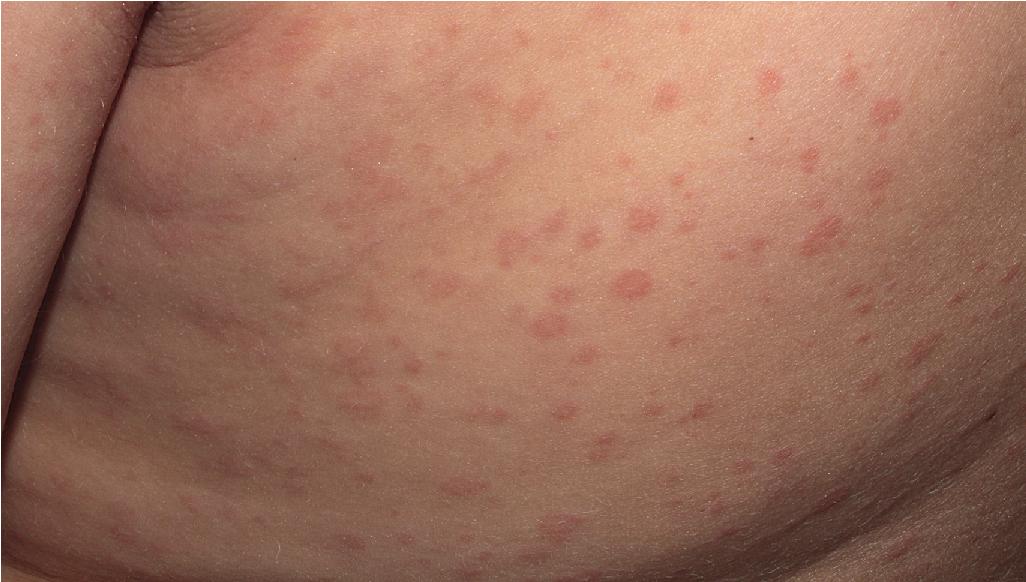
Many patients have extraarticular features, particularly hepatosplenomegaly, lymphadenopathy, pleuritis, and pericarditis, which may predate the joint manifestations by weeks to, rarely, years. A feature in pathogenesis is the increase in cytokines interleukin (IL)–1 and IL-6. Approximately 50% of affected individuals have a mild oligoarticular course with a good prognosis for remission; of the remaining 50%, approximately half will develop severe, recalcitrant, and destructive progressive polyarticular arthritis, although the increased availability of effective interventions is likely altering this high risk. Other complications of systemic-onset JIA include secondary amyloidosis, secondary infection, osteoporosis, and growth retardation. Macrophage activation syndrome (MAS), a life-threatening complication, affects 5% to 8% of patients (see later). In children with MAS, the evanescent skin rash is noted significantly less often than without MAS. ,
Dysfunction in the innate immune system, its clinical features, and its poor response to therapies that ameliorate other forms of JIA have led several investigators to classify sJIA as an autoinflammatory, rather than autoimmune, disease (see Chapter 25 ). , In fact, an autosomal recessive subset of JIA was discovered, resulting from biallelic mutations in FAMIN (also called LACC1 ), which encodes laccase (multicopper oxidoreductase) domain-containing 1, an enzyme that is involved in regulation of inflammasome activation and promotion of reactive oxygen species (ROS) production. Some patients have JIA that is more typical of sJIA, with the characteristic quotidian fever and associated eruption, symmetric polyarthritis affecting small and large joints, but lower frequencies or organomegaly, lymphadenopathy, and serositis. Others have been described with seronegative polyarthritis.
Oligoarticular JIA occurs more often in girls than in boys and peaks between the ages of 2 and 4 years. Children with oligoarticular JIA often complain of morning stiffness and may limp. Joints are warm and effused but not red, hot, or very painful. In about 50% of cases, the onset is monoarticular, with the knee, ankle, or elbow most commonly affected; the hip and small joints are usually spared. The acute onset of painful monoarthritis with refusal to bear weight is unlikely to be JIA, and infectious, traumatic, and malignant causes of joint pain should be considered. Approximately 20% to 30% of children with JIA have uveitis, which occurs most commonly in ANA-positive girls with early–onset oligoarthritis. , The classic picture is a chronic bilateral anterior uveitis, which is usually asymptomatic until significant, and sometimes irreversible damage to intraocular structures occurs. Patients with oligoarticular JIA and uveitis have worse ocular outcomes relative to patients with other causes of uveitis, necessitating regular screening examinations. Treatment of the uveitis includes topical corticosteroids, mydriatics, systemic immunosuppressive agents, and surgical management of complications.
Polyarthritis (≥5 joints) usually has an insidious onset, although it may be acute. It often symmetrically involves the small joints (particularly of the hands and, less often, feet) and wrists. The temporomandibular and hip joints and cervical spine are often affected as well. Lymphadenopathy, hepatomegaly, and fevers may occur, although the fevers do not show the daily (quotidian) spikes seen in sJIA.
Children with enthesitis-related arthritis have characteristics of both JIA and juvenile spondyloarthropathies, with inflamed tendons (enthesopathy is inflammation of the attachment sites of tendons to bone), especially the Achilles tendons, in addition to asymmetric arthritis of one or more joints (typically of the lower extremities). Most affected individuals are boys older than age 6 years. Although children rarely show typical ankylosing spondylitis at onset, spondyloarthropathy not uncommonly develops by adulthood. Arthritis associated with inflammatory bowel disease is a subset of this type. Acute anterior uveitis can occur in up to 27% of children and tends to present as an acutely painful, red, photophobic eye in contrast to the asymptomatic uveitis seen in oligoarticular JIA. RF and ANA are negative, and 65% to 80% are HLA-B27 positive.
Although more characteristic of SLE, scleroderma, and dermatomyositis, patients with JIA may also demonstrate cuticular telangiectasias. Subcutaneous nodules rarely are seen in children with JIA and occur most commonly in patients with RF-positive polyarthritis, particularly if the disease is recalcitrant to therapy. Barely palpable to several centimeters in size, they may be the first presenting sign of JIA. Their most common location is near the olecranon process on the ulnar border of the forearm. Less commonly, they may occur on the dorsal aspect of the hands, on the knees and ears, and over pressure areas such as the scapulae, sacrum, buttocks, and heels. In the areas of fingers and toes, subcutaneous nodules are only a few millimeters in size. Subcutaneous nodules are firm and nontender and may be attached to the periarticular capsules of the fingers. They can be easily confused with the subcutaneous form of granuloma annulare (see Chapter 9 ). Rheumatoid nodules and JIA must also be distinguished from fibroblastic rheumatism, a rare disorder characterized by the sudden but sometimes progressive onset of cutaneous nodules ( Fig. 22.2 ), flexion contractures, and polyarthritis. , Some affected individuals respond to methotrexate. Although methotrexate and tumor necrosis factor (TNF) inhibitor treatment have been linked to induction of subcutaneous nodules, particularly in rheumatoid arthritis, this nodulosis has only been described in adults.
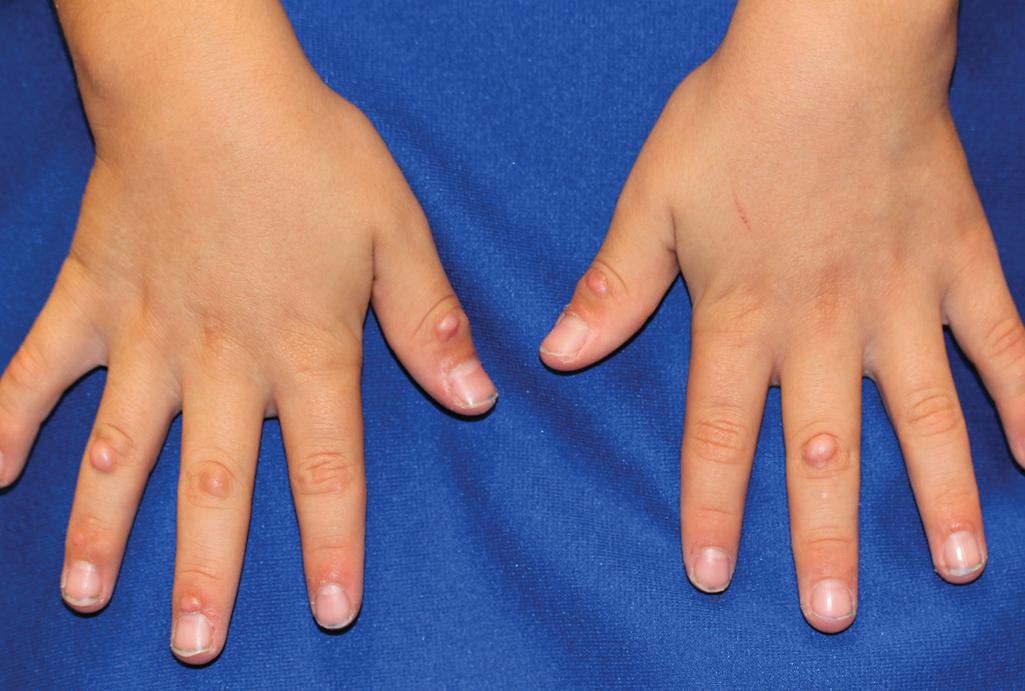
Traditional nonsteroidal antiinflammatory drugs (NSAIDs) continue to be the first-line therapy in all but those with systemic JIA, , in addition to physical therapy and psychosocial support. NSAIDs that preferentially inhibit the cyclooxygenase-2 (COX-2) enzymes have fewer gastrointestinal (GI) adverse effects and may be preferred in some patients. Pseudoporphyria , presenting with tense blisters in photodistributed sites, has most commonly been associated with the use of naproxen sodium but has been reported after administration of other NSAIDs as well, including COX-2 inhibitors (see Chapter 19 ).
Intraarticular injections of corticosteroids are used for children who do not respond to NSAID therapy or as initial therapy for oligoarthritis, but the use of steroids is otherwise limited because of low efficacy in preventing joint destruction and their many potential side effects.
Disease modifying antirheumatic drugs (DMARDs) are nonsteroidal, non-NSAID drugs, and include biologics and nonbiologics. The DMARD methotrexate is usually the second line of treatment for persistent, active arthritis but is best initiated early in the disease course. Patients with oligoarticular arthritis tend to respond most favorably. , Blockade of TNF with biologics (etanercept, infliximab, adalimumab) in combination with methotrexate is particularly effective for children with polyarticular arthritis. Others with efficacy are abatacept (fusion protein that downregulates T-cell stimulation) and rituximab (anti–B-cell antibody). Sulfasalazine has largely been used for enthesitis-related arthritis and oligoarthritis.
Systemic-onset JIA responds poorly to NSAIDs and TNF-α blockers (30% response). In addition to methotrexate , and abatacept (T-cell–activating agent/IgG1 fusion protein), inhibitors of IL-1 (anakinra and canakinumab) , and IL-6 (tocilizumab, humanized anti–IL-6 receptor monoclonal antibody) are increasingly being used for sJIA (with canakinumab preferred to anakinra because of its longer half-life and fewer injection site reactions). Moderate or high dosages of systemic corticosteroids, including pulse intravenous steroids to avoid long-term high-dose treatment, are occasionally used for short periods while awaiting the effects of other medications. As a chronic inflammatory disorder and in relation to use of systemic corticosteroids, JIA is associated with an increased risk of osteoporosis, which can be countered by treatment with calcium and vitamin D supplementation, bisphosphonates, and calcitonin.
Macrophage activation syndrome, a severe, life-threatening complication of systemic-onset JIA, systemic lupus erythematosus (∼9% of children with SLE), and other connective tissue diseases, is associated with hemophagocytosis of activated macrophages/histiocytes and multiorgan dysfunction. When observed in the absence of underlying connective tissue disease, this diagnosis is termed hemophagocytic lymphohistiocytosis (HLH) and can be primary (when familial) or secondary (typically in the setting of infection or malignancy) (see Chapter 10 ). The pathophysiology of both MAS and HLH are speculated to involve inability of natural killer (NK) or CD8 T cells to lyse infected antigen-presenting cells, leading to ongoing infection and resultant “cytokine storm.” Patients with MAS and systemic JIA have been shown to harbor defects in NK-cell function and in genes that encode proteins crucial to lymphocytic cytolytic activity, including Munc 13-4 and perforin, which are also implicated in primary familial hemophagocytic lymphohistocytosis. Clinical signs of MAS in sJIA are fever, hepatomegaly, splenomegaly, lymphadenopathy, central nervous system disease, hemorrhagic manifestations, and bone marrow hemophagocytosis. Patients often develop disseminated intravascular coagulation, which has a rapid course and may be lethal. Encephalopathy, respiratory distress, and renal failure have also been described.
The disease may present as pancytopenia with a falling erythrocyte sedimentation rate (ESR), in contrast to the increased ESR associated with flaring JIA. Formal diagnostic criteria for MAS in sJIA that have been used to develop a validated clinical score are hyperferritinemia (>684 ng/mL) and any two of the following characteristics: decreased platelet count (≤181 x 10 9 /L), increased aspartate aminotransferase (>48 U/L), hypofibrinogenemia (≤360 mg/dL), and hypertriglyceridemia (>156 mg/dL). Although macrophage hemophagocytosis in the bone marrow is a valuable sign, it is absent in >20% of patients, especially during the early stages. A scoring tool has been developed for diagnosing MAS with sJIA that includes age of onset, neutrophil count, fibrinogen level, splenomegaly, platelet count, and hemoglobin. Serum soluble CD163 is a sensitive biomarker of MAS disease activity in sJIA. Early recognition of MAS and treatment with high-dose corticosteroids with or without cyclosporine, etoposide, intravenous immunoglobulin (IVIG), and/or etanercept may be lifesaving. Some patients with sJIA responding to tocilizumab or canakinumab have developed MAS, although some characteristic features (fever, high ferritin levels) may be masked by treatment.
Systemic lupus erythematosus (SLE) is a heterogeneous autoimmune disease characterized by autoantibody accumulation with immune complex deposition leading to end-organ damage. It often involves the skin but may affect almost any organ system. Autoantibodies are the hallmark of SLE, and activated B cells, T helper cells, and the cytokines that modulate inflammatory responses are thought to be the most appropriate targets for therapy. In cutaneous lupus, skin lesions show an antiepithelial cytotoxic immune response with release of cell debris and reactivation of epidermal innate immune pathways (via pattern recognition receptors), self-amplifying the proinflammatory response (especially with release of type I and III interferons and interferon-regulated proinflammatory cytokines and chemokines, particularly CXCR3 ligands CXCL9, CXCL10, and CXCL11).
Both genetic and environmental (especially ultraviolet light) factors are thought to play roles in its pathogenesis. Reports of familial cases and a high concordance for clinical disease in monozygotic, but not dizygotic, twins support a strong genetic contribution to the development of SLE. SLE has been linked to at least 80 genetic susceptibility loci that encode protein products involved in innate and adaptive immunity, particularly in pathways of apoptosis and immune complex/cell debris clearance, activation of toll-like receptors (TLRs), and signaling of type I interferon (IFN) and nuclear factor (NF)–κB. The availability of whole-exome sequencing has led to the discovery of pathogenic mutations in autosomal recessive juvenile-onset SLE ( PRKCD , encoding protein kinase Cδ), complement deficiency leading to SLE, and autosomal recessive hypocomplementemic urticarial vasculitis (DNASE1L3). Although most individuals with SLE do not have monogenic disease, these discoveries may increase understanding of the pathogenesis and lead to new ideas for therapy.
Environmental triggers, including ultraviolet (UV) light, medications, pesticides, heavy metals, tobacco, and infections, have all been linked to the development of SLE. In particular, exposure to UV light is a trigger, not only for cutaneous manifestations but also for flares of systemic disease.
Approximately 15% to 20% of all cases of SLE occur within the first 2 decades of life. Of these, 60% occur between the ages of 11 and 15 years, 35% between 5 and 10 years, and 5% in children younger than 5 years of age. Other than neonatal lupus erythematosus (NLE), the disorder is rarely seen before the age of 3 years. Disease onset in the first decade of life is associated with a female to male ratio of 4:3, which increases to female predominance in the second decade (4:1), compared with a ratio of 9:1 in patients with adult-onset SLE. The overall incidence of childhood-onset SLE is 0.3 to 0.9 per 100,000 children, and prevalence is 5 to 10 (range, 1.89 to 25.7) per 100,000 children worldwide. Both increased prevalence and severity are seen in Black and Hispanic children, especially because of the increased prevalence of nephritis. Compared with SLE in adults, affected children have more severe disease in general, with an increased incidence of renal, neurologic, and hematologic involvement at the time of diagnosis. In one study, 77% of pediatric patients required moderate to high dosages of corticosteroids, compared with 16% of adult patients.
About 80% of patients with SLE have cutaneous involvement at some time, often as the presenting sign. Diagnosis of SLE requires Systemic Lupus International Collaborating Clinics (SLICC) criteria, which were established in 2012 ( Table 22.1 ). These criteria are more sensitive (but less specific) at classification than the previous criteria established by the American College of Rheumatology in 1982. , The 1982 criteria included four mucocutaneous features: the malar eruption, discoid eruption, photosensitivity, and oral ulcerations. In 2012, the dermatologic criteria for SLE were broadened to include the variety of subtypes of cutaneous lupus under either acute or chronic cutaneous lupus criteria. In addition, to prevent duplication of highly correlated terms related to cutaneous lupus, photosensitivity was replaced with diffuse, nonscarring alopecia.
| Criterion * | Comments | |
|---|---|---|
| CLINICAL CRITERIA | ||
| 1 | Acute cutaneous lupus | Lupus malar rash (fixed erythema, flat or raised, over malar eminences, usually sparing nasolabial folds), bullous lupus, photosensitive lupus rash (not dermatomyositis), maculopapular lupus rash, or toxic epidermal necrolysis variant Subacute cutaneous lupus (nonindurated annular polycyclic or psoriasiform lesions that resolve without scarring) |
| 2 | Chronic cutaneous lupus | Classic discoid eruption (erythematous plaques with adherent keratotic scaling and follicular plugging, often atrophic scarring and dyspigmentation if older lesion; localized if only above the neck, otherwise generalized), lupus panniculitis (profundus), hypertrophic (verrucous) lupus, lupus tumidus, chilblains lupus, discoid lupus/lichen planus overlap, mucosal lupus |
| 3 | Oral ulcers | Palate, buccal, tongue, or nasal mucosa (no other cause identified) |
| 4 | Alopecia, nonscarring | Diffuse thinning or hair fragility in the absence of other causes (such as alopecia areata, iron deficiency, drugs, or androgenetic alopecia) |
| 5 | Synovitis | Must involve two or more joints with swelling or effusion or tenderness and at least 30 minutes of morning stiffness |
| 6 | Serositis | Pleuritis, pleural effusions or pleural rub; pericardial pain, effusion, rub or pericarditis without other cause |
| 7 | Renal | Persistent proteinuria >0.5 g/day or red blood cell casts |
| 8 | Neurologic | Seizures, psychosis, myelitis, mononeuritis multiplex, peripheral or cranial neuropathy, acute confusional state (all without other known cause) |
| 9 | Hemolytic anemia | |
| 10 | Leukopenia | <4000/mm 3 at least once or lymphopenia of <1000/mm 3 at least once without other cause |
| 11 | Thrombocytopenia | <100,000/ mm 3 at least once without other cause |
| IMMUNOLOGIC CRITERIA | ||
| 1 | Positive ANA | Above laboratory reference range |
| 2 | Anti-ds DNA antibody | Above laboratory reference range (more than twofold if by ELISA) |
| 3 | Anti-Sm antibody + | |
| 4 | Antiphospholipid antibody + | + Lupus coagulant or anti–β2-glycoprotein I, medium- or high-titer anticardiolipin antibody, or false positive |
| 5 | Low complement | C3, C4, CH50 |
| 6 | Direct Coombs test | In the absence of hemolytic anemia |
* At least four criteria are required, including at least one clinical and one immunologic criterion. Biopsy-proven lupus nephritis plus a positive ANA or anti-ds DNA is also sufficient.
Cutaneous lupus erythematosus (CLE) may occur as an isolated finding or in the setting of underlying SLE. Features of CLE may be classified as lupus specific or nonspecific, based on clinical and histopathologic characteristics. Lupus-specific subsets of cutaneous disease characteristically demonstrate lupus-specific features on histopathologic examination, including interface dermatitis and mucin deposition. These include acute CLE (ACLE), subacute CLE (SCLE), chronic cutaneous lupus erythematosus (CCLE), and intermittent CLE (ICLE; sometimes included under CCLE). Lupus-nonspecific cutaneous disease includes a variety of reactive phenomena that are not pathognomonic or specific for SLE but typically occur in active disease.
ACLE may present with a malar or butterfly rash or a more generalized morbilliform photodistributed eruption. In particular, the malar rash ( Fig. 22.3 ), although seen in approximately 60% of patients with SLE, is not specific but when present is often a sign of underlying systemic disease. This erythematous, mildly scaling eruption ( Fig. 22.4 ) often appears over the cheeks and bridge of the nose, resembling the shape of a butterfly. It can be confused with the malar erythema of seborrheic dermatitis, erythematotelangiectatic acne rosacea, parvovirus infection, or cutaneous lichenoid graft-versus-host disease ; seborrheic dermatitis typically involves the nasolabial fold and shows scaling as well. Brightly erythematous papules and plaques can also be seen on the photo-exposed extremities and V-shaped region of the neck. When this eruption presents on the dorsal aspect of the hands in SLE, the areas overlying joints are typically spared ( Fig. 22.5 ), in contrast to juvenile dermatomyositis.
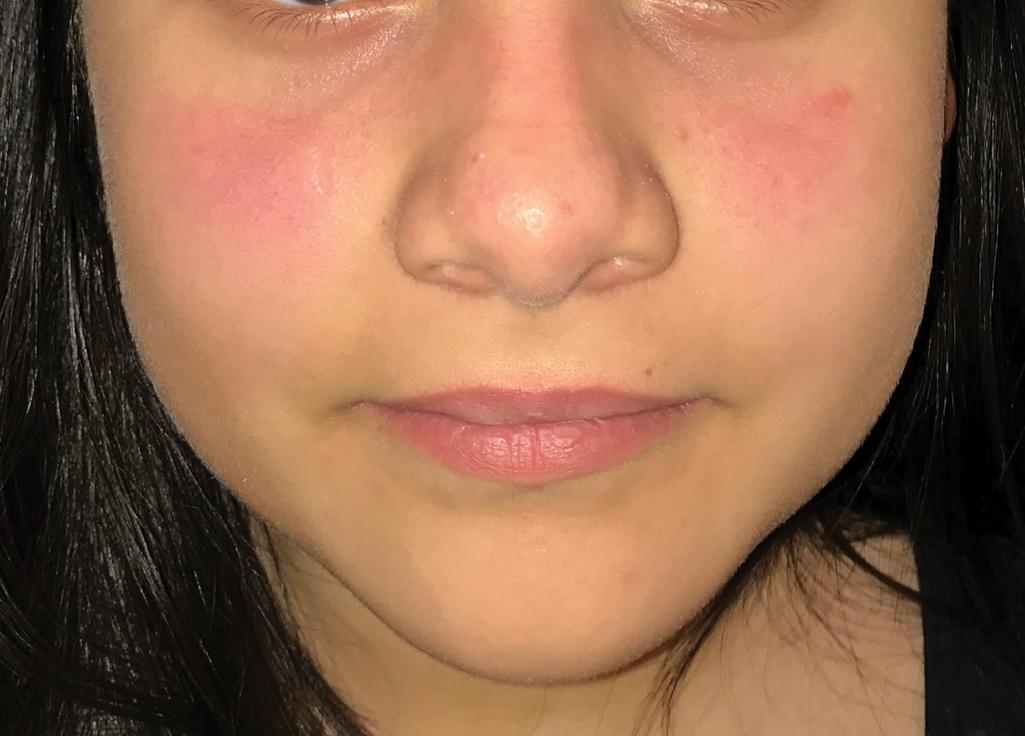
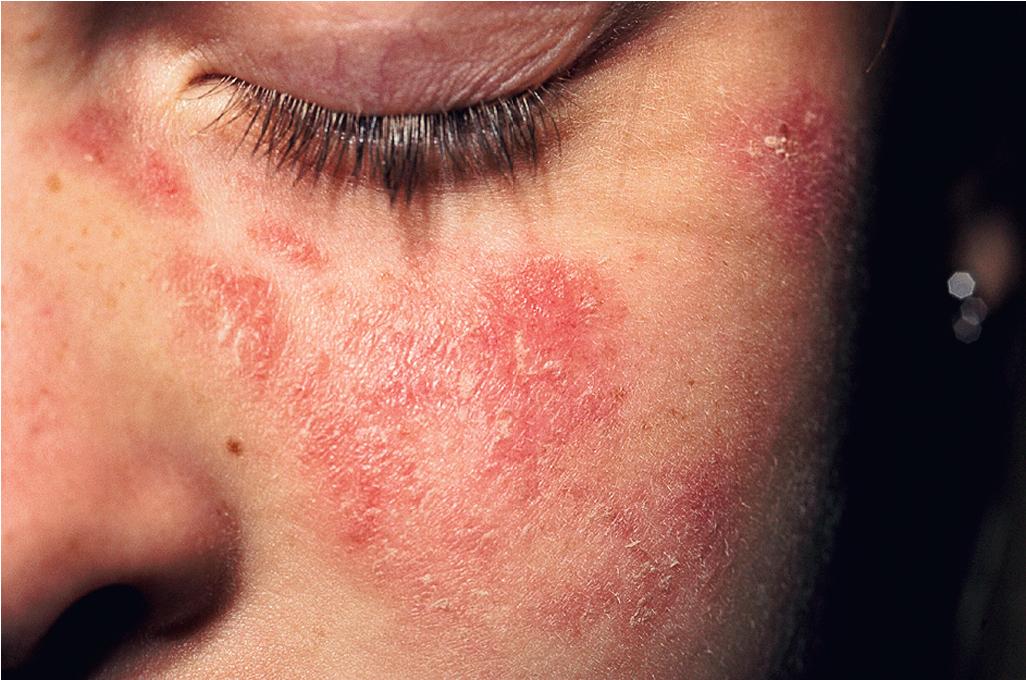
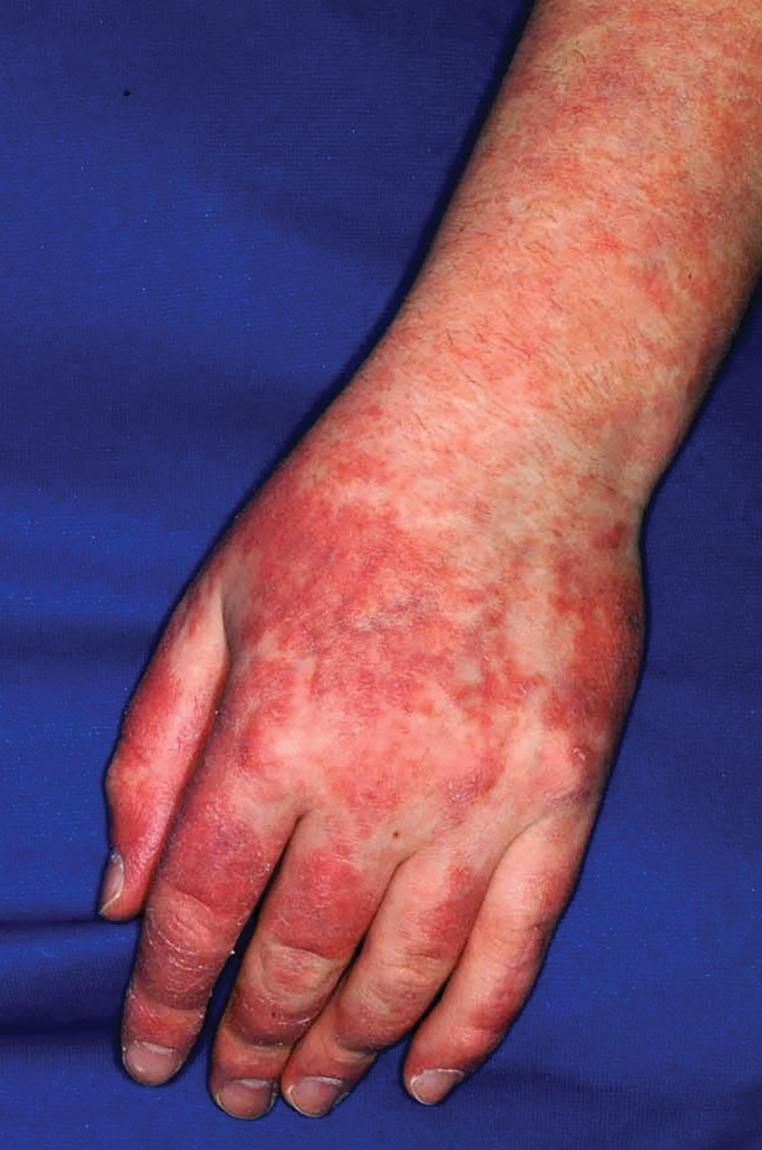
SCLE, which represents 10% to 15% of all cases of CLE, only occasionally occurs in pediatric patients. , The cutaneous lesions of SCLE arise quite suddenly, mainly on the upper trunk, extensor surfaces of the arms, and dorsal aspect of the hands and fingers. The lesions may be annular and may enlarge and merge into psoriasiform or polycyclic lesions ( Fig. 22.6 ) with thin and easily detached scales. UV light is usually associated with exacerbations, but lesions tend to be nonscarring. Although arthritis and fatigue are common, patients usually only have mild systemic manifestations. Most patients with SCLE have anti-Ro (SS-A) antibodies, and many have anti-La antibodies. Nonbullous annular lesions that clinically and histologically resemble Sweet syndrome (see Chapter 20 ) can also be seen as a manifestation of SLE; biopsy shows unique histologic features called the histiocytoid form of neutrophilic dermatosis. Rowell syndrome was originally described as an erythema multiforme–like eruption in association with lupus (classically CLE), anti-La antibodies, and speckled ANAs; although controversy exists, most of these cases are probably SCLE or the concurrence of lupus and erythema multiforme. SCLE is treated by strict sun protection, topical antiinflammatory agents, antimalarials, and occasionally systemic corticosteroids.
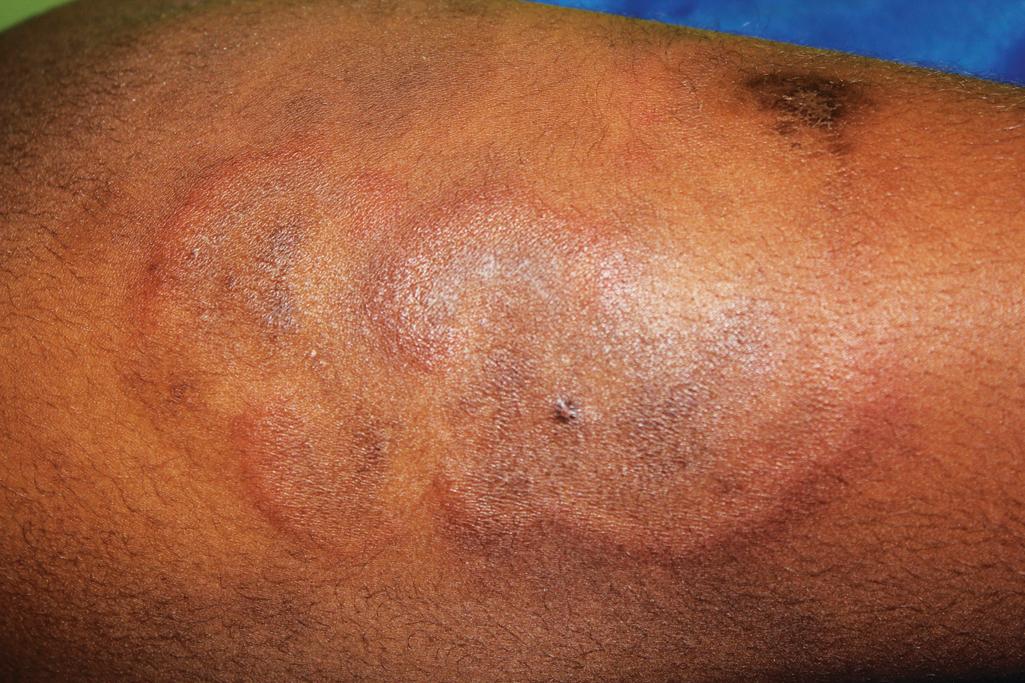
Tumid lupus (lupus erythematosus tumidus) is a form of ICLE. Red to purplish urticarial plaques that are relatively fixed in shape and do not undergo atrophy or scaling usually occur on the face or other exposed areas of the body as a sign of photosensitivity. The progression rate of lupus erythematosus tumidus to SLE is unknown.
CCLE is an umbrella term used to describe lesions of discoid lupus erythematosus (DLE), lupus panniculitis, and chilblain lupus. Individual lesions of DLE are well-circumscribed, elevated, indurated red to purplish plaques with adherent scale ( Figs. 22.7 and 22.8 ) and fine telangiectasia. When untreated or as a sequela, discoid lesions may develop persistent areas of hyperpigmentation or hypopigmentation with atrophy. Discoid lesions can be asymmetric and are often exacerbated by exposure to UV light. Occasionally, discoid lesions are verrucous or hypertrophic. DLE is most commonly found on the face, often with lesions on the ear helices and conchal bowls. Although the face is often the sole site of DLE without SLE, the scalp ( Fig. 22.9 ), arms, legs, hands, fingers, back, chest, abdomen, and even mucosal areas ( Fig. 22.10 ) may also be involved. At times the openings of hair follicles are dilated and plugged by an overlying scale. If the scale is thick enough, it can be lifted off in one piece. The undersurface then reveals follicular projections that resemble carpet tacks, a characteristic sign of LE. Discoid lesions have been described in a linear orientation that follows the lines of Blaschko , and are the most common subgroup of lupus to course along Blaschko lines. Photosensitivity has been reported in only 12% with blaschkolinear lesions, and only 6.5% meet criteria for SLE.


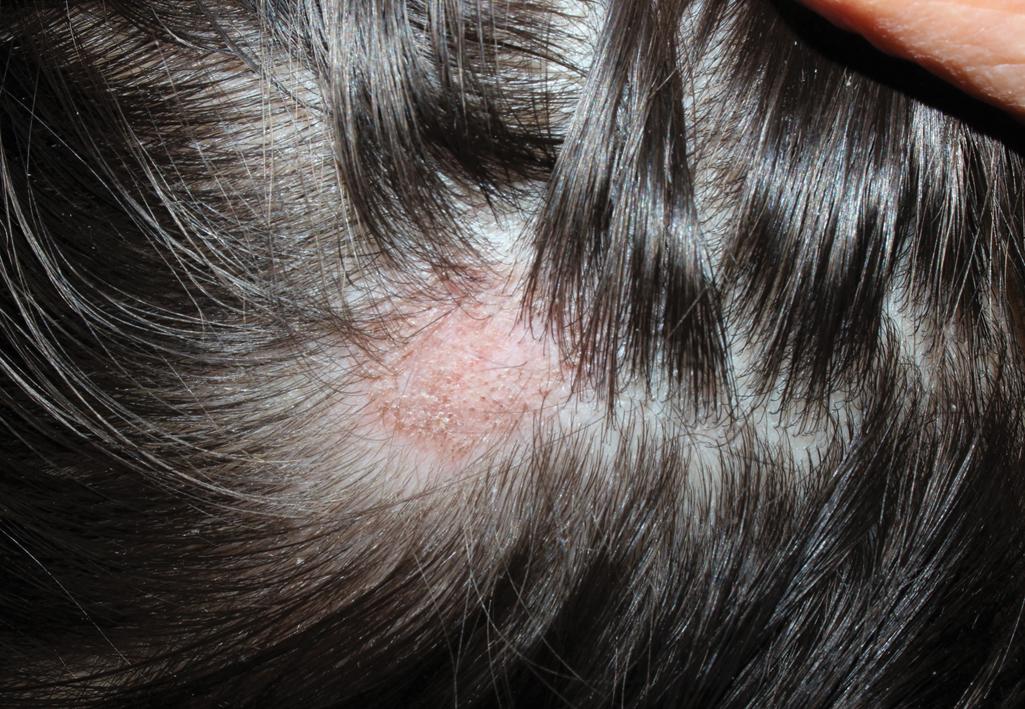
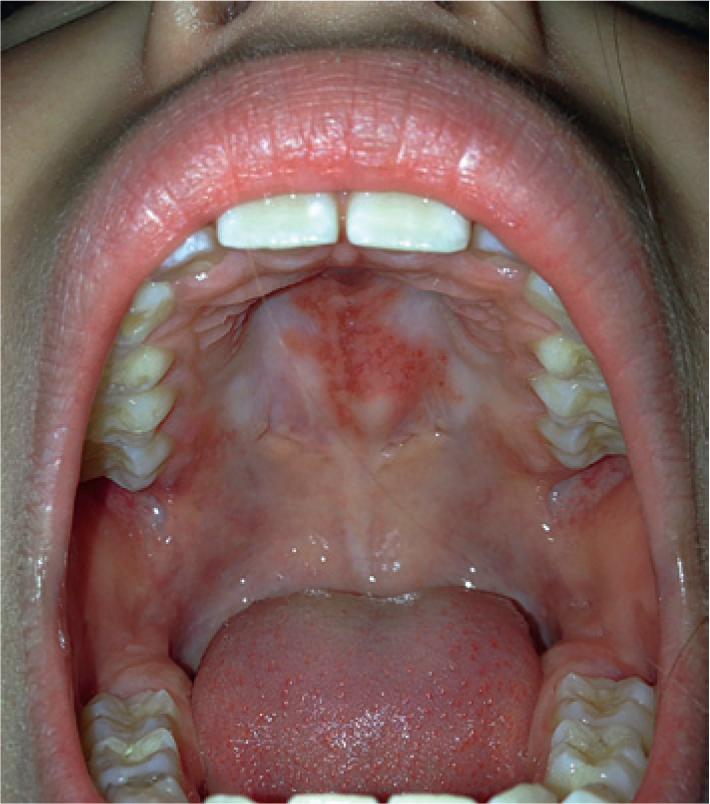
Fewer than 3% of patients with DLE develop disease before the age of 10 years. DLE may present as an isolated finding or as a manifestation of underlying SLE. Small studies in children have demonstrated an early rate of progression to SLE approaching 25% to 30% during a variable follow-up duration of months to years. In one series of 40 patients, 15% presented as DLE with concurrent SLE but 26% eventually met criteria for SLE, with transition most common in the first year after DLE diagnosis, mandating serial clinical and serologic evaluations for systemic disease. Both adults and children with generalized lesions (above/below the neck) are at higher risk for SLE. , , However, children with DLE who develop SLE appear to follow a more benign course of systemic disease, with 89% of patients in one study meeting SLE classification criteria with mucocutaneous limited manifestations and no evidence of end-organ damage during 5 years of follow-up. Based on consensus among pediatric dermatologists and pediatric rheumatologists, (1) screening laboratory testing should include complete blood cell counts with differential, urinalysis, complement levels, erythrocyte sedimentation rate, antinuclear antibody and other autoantibodies, hepatic function, and renal function/electrolytes; (2) the presence of arthritis or nephritis should increase concern about development of SLE; and (3) hydroxychloroquine is the first-line treatment for DLE in an attempt to slow potential progression.
Intense inflammation of the fat (lupus panniculitis, lupus profundus) occurs in approximately 2% to 3% of patients with CLE and may be associated with DLE or SLE or, not uncommonly, may occur as an isolated disorder. Lesions are seen as firm, often asymptomatic, sharply defined, rubbery dermal and subcutaneous plaques or nodules with a predilection for the scalp, forehead, cheeks, upper arms, breasts, thighs, and buttocks. Linear lesions of lupus panniculitis along Blaschko lines have been described on the scalp, particularly in the parietal region, as well as in other locations. Although the skin overlying the lesions usually appears normal, it often ulcerates ( Fig. 22.11 ) or becomes depressed. Linear lupus may also be sclerotic, suggesting overlap with linear morphea.
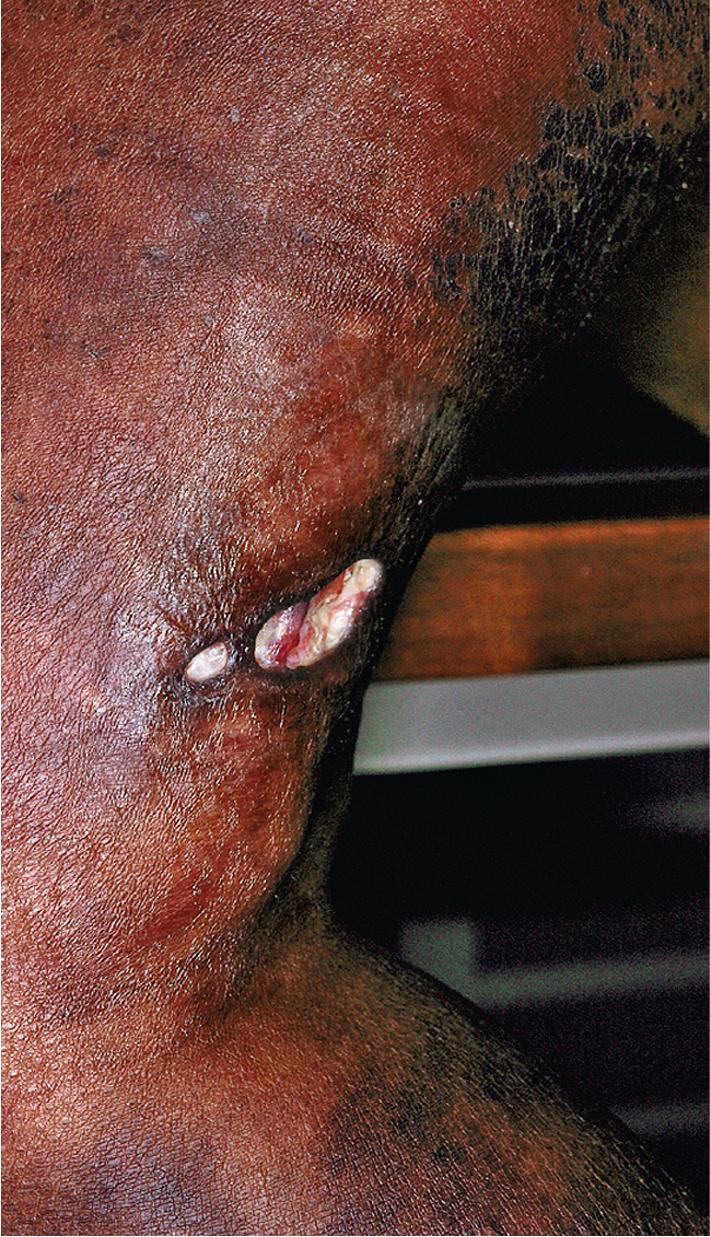
Biopsy of lupus erythematosus panniculitis shows a perivascular lymphocytic, plasma cell, and histiocytic infiltration in the deep dermis and subcutaneous fat without accompanying fat necrosis. The panniculitis may be lobular alone or involve both septae and lobules; most specimens show mucin deposition. Direct immunofluorescence often reveals Igs or C3 deposits at the basement membrane. Approximately 70% of patients with lupus panniculitis also have typical lesions of DLE, and 50% eventually develop systemic involvement or symptoms of SLE such as fever, arthralgia, and lymphadenopathy. Lesions of lupus profundus may persist for years and leave significant disfigurement. Although erythema nodosum (see Chapter 20 ) may occur in a patient with SLE, lupus panniculitis can often be distinguished from erythema nodosum by its relative lack of tenderness, greater chronicity, and lack of predilection for the lower legs. Lupus panniculitis must also be distinguished from subcutaneous lymphoma by histologic features and T-cell rearrangement studies.
Inflammatory panniculitis followed by lipoatrophy, likely autoimmune in mechanism but not associated with SLE or dermatomyositis, can involve localized areas, such as the ankles ( Fig. 22.12 ) or abdomen. Lipoatrophic panniculitis can also be seen in type 1 diabetes, Hashimoto thyroiditis, and JIA, which may manifest years after the onset of the panniculitis. The tender erythematous nodules demonstrate lobular panniculitis on histopathologic examination. With clearance, these nodules leave lipoatrophy that may progress to partial or even generalized lipodystrophy. Administration of systemic corticosteroids and/or steroid-sparing agents such as methotrexate can stop the development of nodules. Lipodystrophy and tender erythematous nodules are also a feature of chronic atypical neutrophilic dermatosis with lipodystrophy and elevated temperature (CANDLE syndrome), a proteasome autoinflammatory disorder (see Chapters 20 and 25 ).
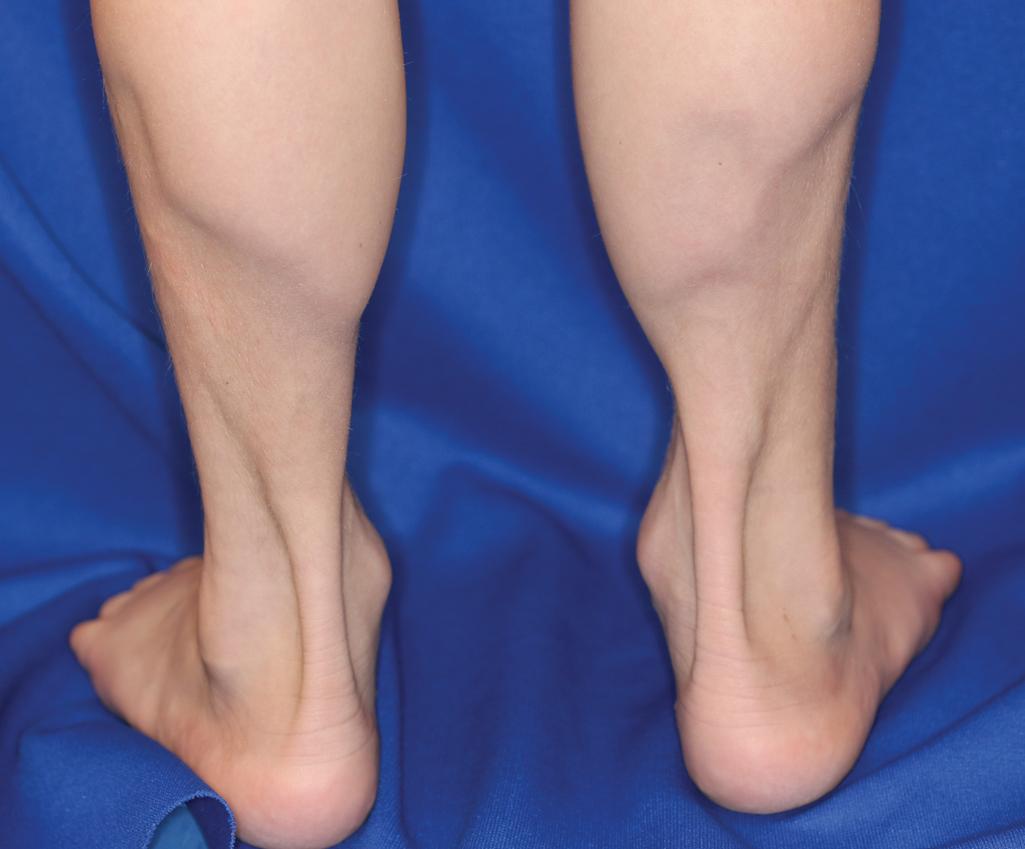
Nonspecific manifestations of SLE are distinguished by the absence of lupus-specific changes on histopathologic examination. These include a variety of reactive and inflammatory eruptions and are typically observed in active SLE. Livedo reticularis ( Fig. 22.13 , see also Fig. 12.90 ) blotchy bluish-red discoloration of the skin caused by vasospasm, is seen in several collagen vascular disorders, among them SLE, drug-induced SLE, APS, and scleroderma. Aggravated by exposure to cold, the reticulated erythema tends to be persistent and is most commonly found on the lower extremities. Vascular changes resembling livedo reticularis can be seen in a variety of genetic disorders with telangiectasia, such as Rothmund–Thomson syndrome (see Chapter 19 ) and FILS (facial dysmorphism, immunodeficiency, livedo, and short stature) syndrome, resulting from biallelic variants in POL E1.
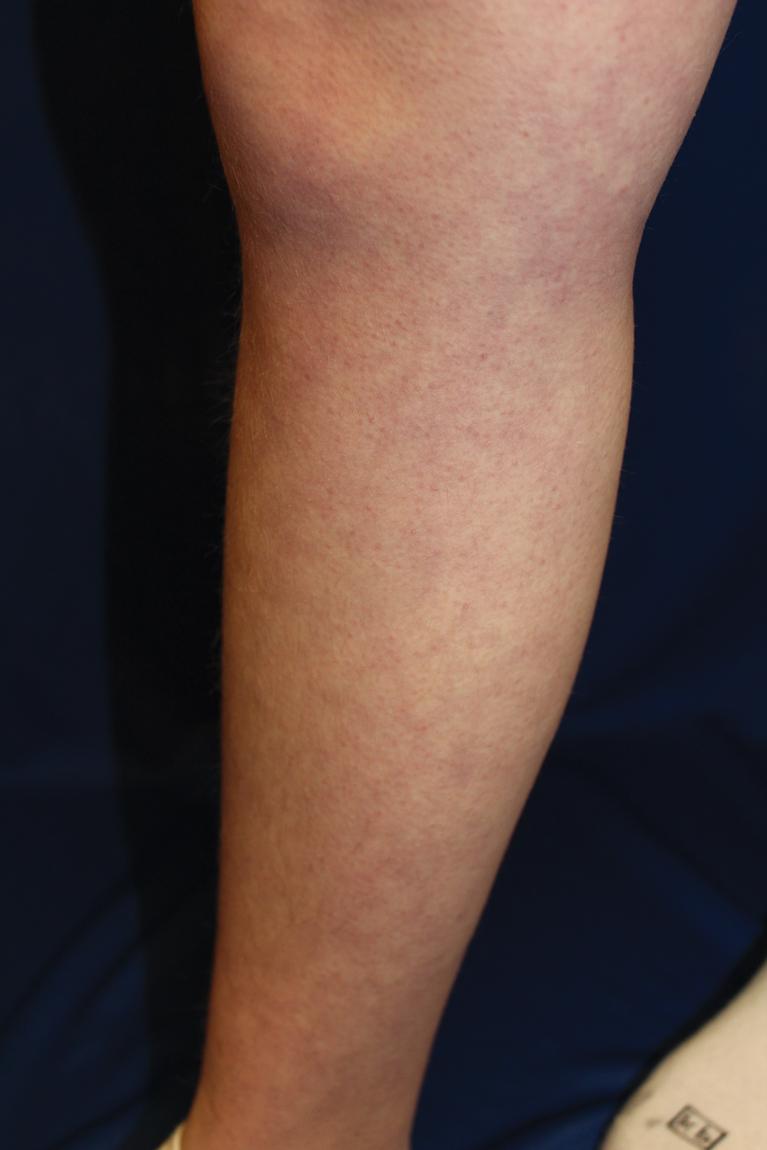
Raynaud phenomenon, seen in 10% to 30% of patients with SLE, may precede the onset of SLE by months or years. This phenomenon is described in more detail in the section on systemic sclerosis (SSc). Pernio (chilblains) are tender cyanotic to reddish-blue nodular swellings on the fingers or toes (see Chapter 20 ). Chilblain lupus manifests as cold-induced, reddish-blue, inflammatory acral lesions that may ulcerate (see Chapter 20 ). Although sporadic chilblain lupus has been described in adolescents, most of the affected younger children have a familial form of chilblains, Aicardi–Goutières syndrome (see Chapter 20 , Fig. 20.50 ). Chilblains must be distinguished from stimulator of interferon genes (STING)–associated vasculopathy with onset in infancy (SAVI) syndrome, an autoinflammatory disorder with acral vasculopathy that can be exacerbated by cold (see Chapter 25 , Fig. 25.34 ). ,
Chronic urticaria-like lesions (urticarial vasculitis) in children with SLE may be distinguished from classic urticaria by their tendency to persist longer than 24 hours and their lesser tendency to be pruritic (see Chapter 21 , Fig. 21.15 ). A manifestation of immune complex deposition, urticarial vasculitis generally occurs in patients demonstrating clinical or serologic evidence of systemic disease activity, especially hypocomplementemia. Biopsy confirms the presence of leukocytoclastic vasculitis. Leukocytoclastic vasculitis can also be seen in biopsy specimens from purpuric lesions in patients with SLE. These purpuric lesions may ulcerate, leaving significant scarring. Erythema and papular telangiectasia of the palms and fingers ( Fig. 22.14 ), linear telangiectasia of the cuticles and periungual skin (with or without thromboses), and periorbital or hand and feet edema are other nonspecific cutaneous features of SLE.
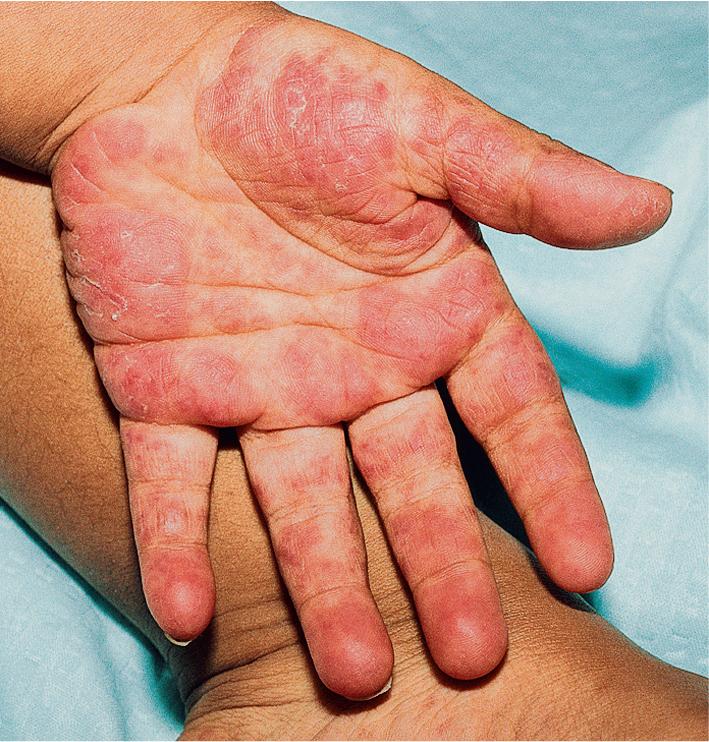
Although bullous or crusted lesions of SLE may simply reflect fragility of skin because of liquefaction degeneration of basal keratinocytes, a distinctive (and rare) complication of SLE resembles bullous or epidermolysis bullosa acquisita (EBA) and has been called bullous (or vesiculobullous ) SLE ( BSLE ; see Chapter 13 , Fig. 13.41 ). The treatment of choice is dapsone. Indirect immunofluorescence on salt-split skin shows Ig and C3 deposits on the dermal side, and immunoblotting shows autoantibodies directed against type VII collagen, as in patients with EBA (see Chapter 13 ). , Subtle variations in IgG subtypes between EBA and BSLE have been shown by IgG subtyping. Other forms of immunobullous disorder, such as linear IgA disease, have also been described in association with SLE, emphasizing the need for immunofluorescence testing.
Mucin deposition is a typical characteristic seen on skin biopsy sections of individuals with SLE. However, skin-colored, sometimes pruritic papules and nodules involving primarily the trunk, upper extremities, and occasionally the face are a clinical feature of SLE that reflects large amounts of mucin in the mid-dermis between collagen bundles , ( Fig. 22.15 ). Papulonodular (dermal) mucinosis of SLE may occur any time during the course, including before onset of other features, and has a course that is independent of the course of the SLE. Mucinosis in children is also a histologic feature of self-healing juvenile cutaneous mucinosis, an unusual disorder characterized by the acute onset of multiple skin-colored to dusky erythematous asymptomatic papules and nodules. Lesions mainly occur on the head and periarticular areas and can be a few centimeters in diameter ( Fig. 22.16 ), in contrast to the more diffuse and, if discrete, papular lesions of the papulonodular mucinosis of SLE. Fever, muscle tenderness, arthralgias, and weakness may be associated. Lesions spontaneously resolve during the subsequent months to a few years. Biopsy samples can be erroneously misdiagnosed as panniculitis or proliferative fasciitis, but mucin stains allow the characteristic deposition of large amounts of mucin to be identified so that the family can be reassured.
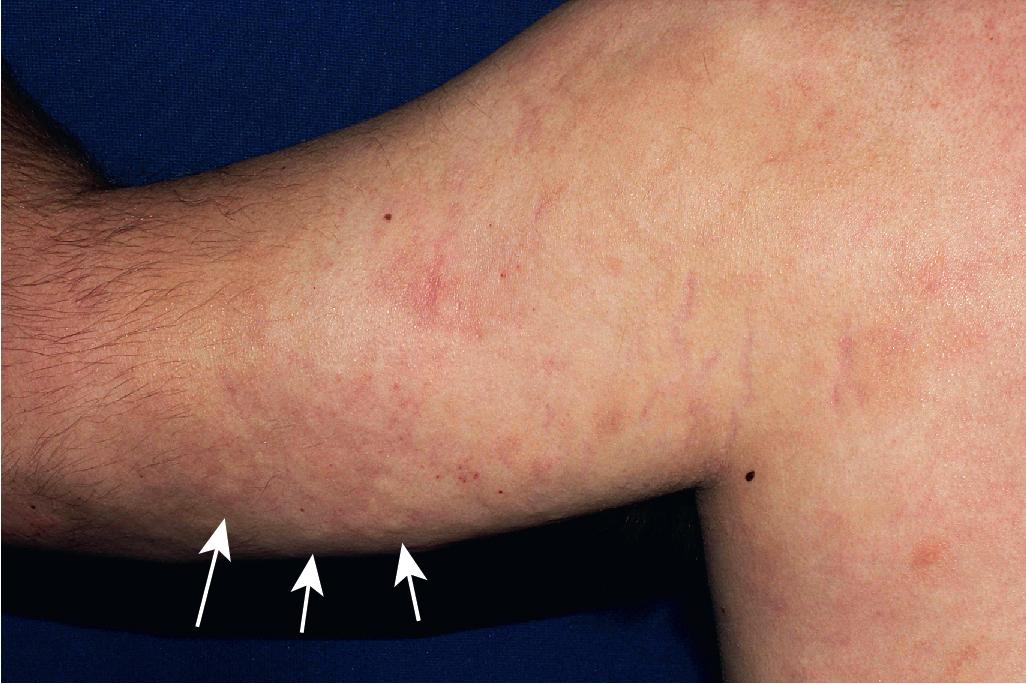
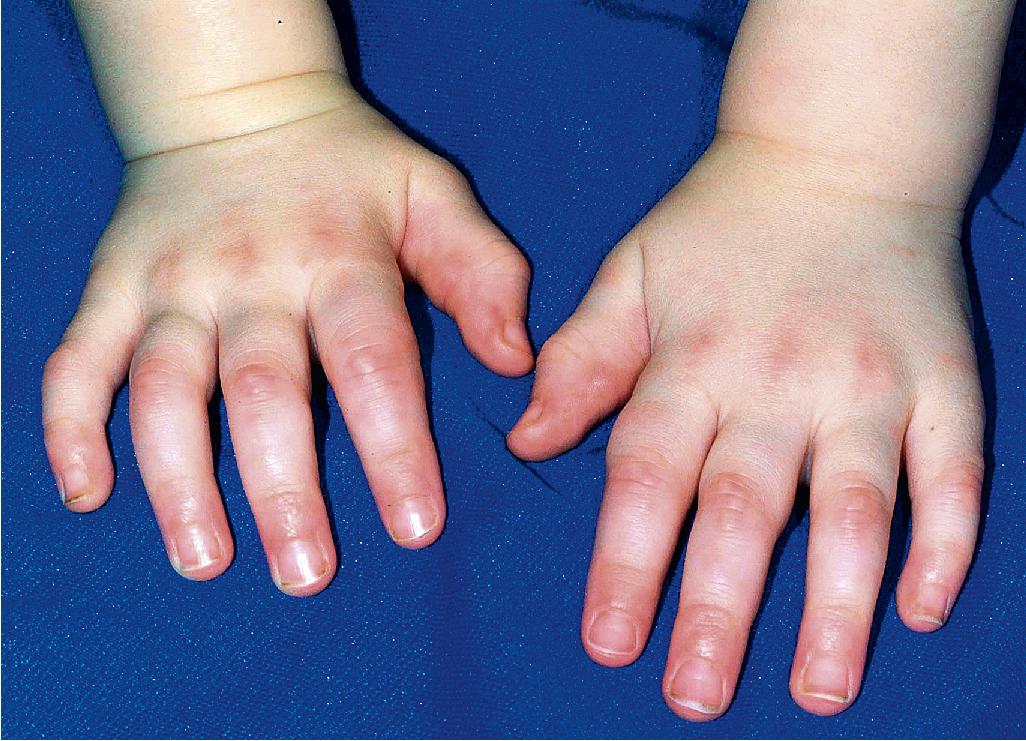
Mucosal membrane lesions (gingivitis, mucosal hemorrhage, erosions, and small ulcerations) are seen in 3% of patients with CLE and in up to 30% of pediatric patients with the systemic form of the disorder. A silvery whitening of the vermilion border of the lips is highly characteristic, and the lips may show slight thickening, roughness, and redness, with or without superficial ulceration and crusting ( Fig. 22.17 ). The gingival, buccal, and nasal mucosae may also appear red, edematous, friable, and eroded or may exhibit silvery white changes.
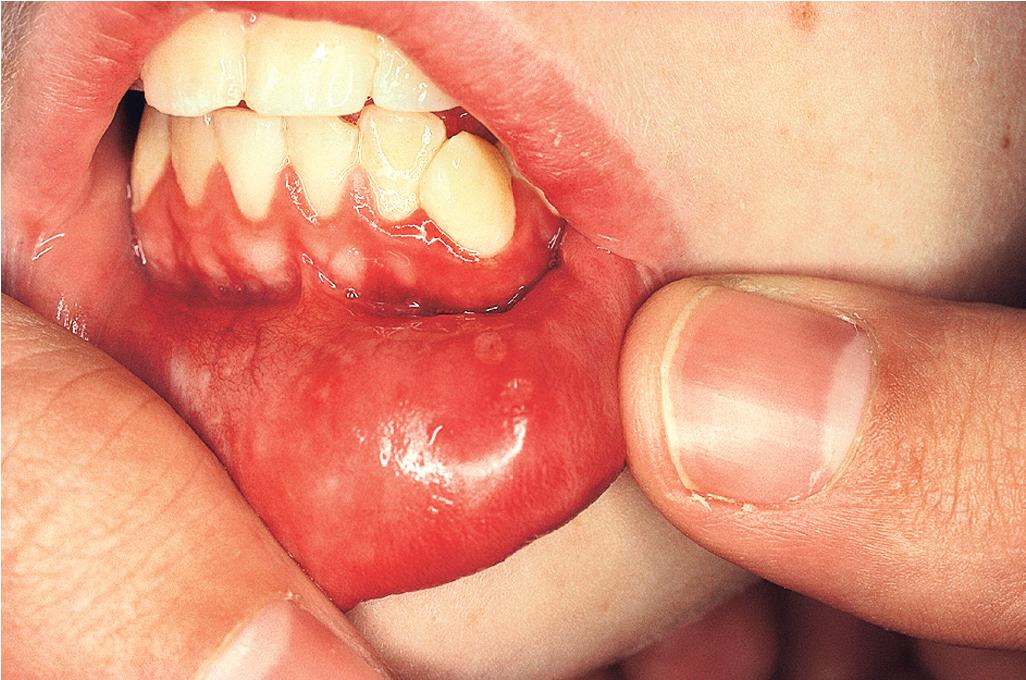
Several forms of alopecia may occur in patients with SLE (overall in about 30% of patients). First, discoid lupus may present with scarring alopecia associated with multiple well-demarcated patches ( Fig. 22.18 ) that exhibit erythema, scaling, telangiectasia, atrophy, and plugging (the classic changes of DLE). Second, patients with SLE may develop hair fragility, especially with acute exacerbations, that leads to hair breakage several millimeters from the roots, resulting in a receding hairline with a short, unruly, broken hairs (“lupus hair”), especially at the temple and forehead. Telogen effluvium may also occur in patients with SLE. Finally, there is an increased incidence of alopecia areata in patients with SLE, and these patients tend to have classic scalp dermoscopic findings including exclamation-mark hairs, black dots, broken hair, and yellow dots (see Chapter 7 ). ,
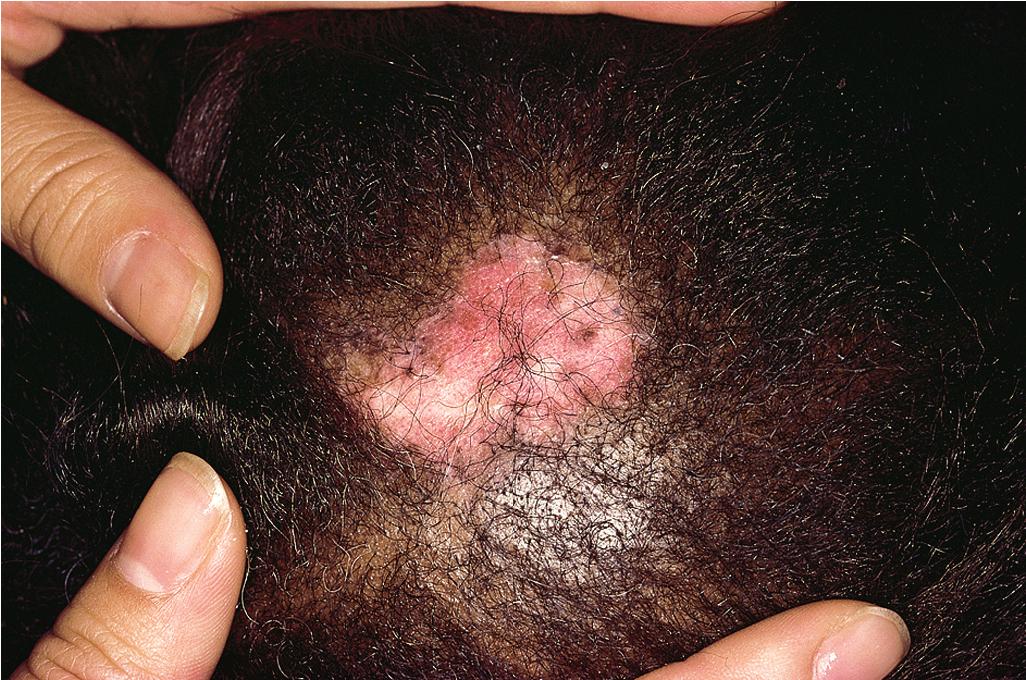
The most common symptoms of SLE at presentation are constitutional (malaise, fever, and weight loss). The arthritis, which occurs in up to 79% of pediatric patients, , is a symmetric polyarthritis involving both small and large joints. It is commonly quite painful (in contrast to the arthritis of JIA), often out of proportion to the clinical findings, and tends to be nondeforming. Approximately 55% of pediatric patients develop renal involvement, most often during the first year of the SLE. Four types of nephritis have been described based on renal biopsy pattern: mesangial lupus nephritis, focal proliferative, diffuse proliferative, and membranous glomerulonephritis. Diffuse proliferative glomerulonephritis occurs most commonly (40% to 50%) but carries the worst prognosis, leading to end-stage renal disease in approximately 10% to 15% of patients with lupus nephritis. The presence of anti–double-stranded (anti-ds) deoxyribonucleic acid (DNA) antibodies and hypocomplementemia is commonly associated with severe renal damage. Pulmonary involvement, particularly pleuritis, occurs in up to 30% of patients. Cardiac manifestations, including pericarditis, myocarditis, vasculitis affecting coronary arteries, and Libman–Sacks endocarditis, occur in approximately 15% of patients. A recognized issue, however, is the long-term risk of accelerated atherosclerosis ; the overall survival for SLE has improved for all causes except cardiovascular disease. Individuals with childhood-onset SLE can develop myocardial ischemia as early as 20 to 30 years of age.
Neuropsychiatric SLE (central nervous system [CNS] involvement) most commonly features headache, seizures, alterations in mental status, psychosis, and peripheral neuropathy and is seen in 20% to 30% of affected children ; most show evidence of neuropsychiatric involvement during the first year of the disease, but cognitive dysfunction occurs in almost 25%. Neuroimaging studies may show structural abnormalities, such as infarction; the addition of single-photon emission computed tomography (SPECT) scans may identify evidence of cerebral vasoconstriction and vasculitis as perfusion abnormalities and allow a diagnosis of lupus psychosis.
Lymphadenopathy, although it occurs more commonly in adults, is seen in up to 40% of children with SLE. Ocular findings are seen in 25% of patients (cotton-wool patches, optic neuropathy, perivasculitis, and edema of the optic disk). MAS occurs in approximately 9% of childhood-onset SLE, typically presents with high fever, and in some patients is associated with organ involvement (hepatomegaly, splenomegaly, neurologic signs, pancytopenia, coagulopathy, and high levels of liver enzymes, ferritin, and triglycerides [see Macrophage Activation Syndrome earlier this chapter]). The mortality rate of SLE is higher if MAS is associated. In patients with suspected MAS, a bone marrow aspirate should be performed to consider cytopenia and possible hemophagocytosis. Ferritin levels will help to distinguish MAS from infection, in which hyperferritinemia tends to be less than in MAS.
The diagnosis of SLE is chiefly clinical and is based on the presence of cutaneous lesions, systemic manifestations, and confirmatory laboratory tests (see Table 22.1 ). Biopsy of cutaneous lesions will confirm the diagnosis and shows (1) hyperkeratosis with keratotic plugging; (2) epidermal atrophy; (3) liquefactive degeneration of basal cells; and (4) a patchy, chiefly lymphoid cell infiltrate, especially around appendages and vessels. Biopsy of lesional skin in DLE or SLE usually shows the deposition of immunoreactants at the epidermal–dermal border (the lupus band test). Sun-exposed areas should be avoided for this biopsy, if possible, because of the risk of a false-positive lupus band test at sun-exposed sites. Chest radiographs, electrocardiography, and echocardiography have been recommended as baseline screening components for any child with SLE.
Serologic examination is the most important evaluation for children thought to have SLE, and ANA is the most valuable screening test. The serologic profiles in children with SLE are similar to those of adults, although some authors have reported a slightly increased incidence of positive antibody tests. The ANA test is almost always positive when a human substrate is used (e.g., Hep-2 cells); in contrast, 5% to 10% of patients with SLE have a negative ANA test when nonhuman tissues are used for testing. Having a positive ANA test does not make a diagnosis of lupus. It can be seen in patients with several other collagen vascular disorders and is present in 5% to 10% of the normal population. However, an ANA level greater than 1:160 usually suggests an autoimmune disorder. Five patterns of ANA have been described: speckled (the most nonspecific), homogeneous, peripheral or shaggy (most patients with SLE and this pattern have anti-ds [also called native ] DNA antibodies), nucleolar (often seen in patients with scleroderma), and centromere (largely associated with calcinosis, Raynaud, esophageal dysmotility, sclerodactyly, and telangiectasia [CREST]; see discussion on SSc).
Monitoring of serum complement is a critical test for determining lupus activity. The development of hypocomplementemia commonly signals the onset of renal disease. Total complement activity is monitored by functional hemolytic assay (CH50). Specific complement levels, particularly of C3 and C4, should be routinely checked by single radioimmunodiffusion assay. Not uncommonly, C4 levels may be depressed when C3 is normal, probably because patients with SLE are often missing one or more C4 allele.
One risk factor for the development of SLE, especially with onset during childhood, is hereditary deficiency of the early complement components, C1 (C1q and less often C1r/s), C4, C2, and C3. Screening for complement deficiency via CH50, AP50, C3, and C4 (or specific complement levels if appropriate) is important for younger children in particular. Virtually all children with C1q deficiency develop manifestations of lupus ( Fig. 22.19 ). The SLE that occurs in complete C1- or C4-deficient individuals typically presents early during childhood. C2-deficient individuals tend to have a lower risk and less severe disease with lower titers of antinuclear antibodies but increased anti-Ro antibodies. Lupus and other autoimmune disorders do not tend to occur in individuals with deficiency of the later components of complement, which instead are associated with an increased risk of developing infections, including neisserial infections. Lupus has also been seen in patients with chronic granulomatous disease, female carriers of the X-linked form of chronic granulomatous disease, and patients with IgA deficiency.
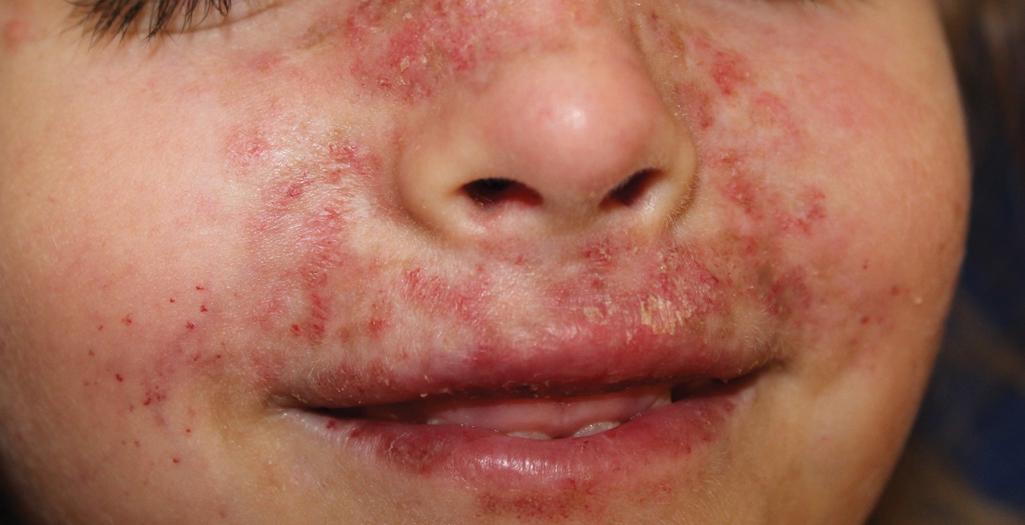
Children who may have lupus should be tested for the presence of anti-ds DNA antibodies, which are found in about 50% of patients with SLE and have been associated with an increased risk of renal disease, particularly if complement levels are low. In contrast, antiribosomal P antibodies are inversely associated with renal involvement in juvenile-onset SLE. Anti–single-stranded (ss) DNA antibodies are found in about 70% of patients and are nonspecific. However, complement-fixing anti-ss DNA antibodies are associated with renal disease, even without anti-dsDNA antibodies. Some patients with SLE have antibodies directed against nuclear ribonuclear proteins (nRNPs). Patients with anti-nRNP antibodies (30% to 40%) have a lower risk of renal disease and a better prognosis. Anti-nRNP antibodies and a speckled ANA pattern have also been described in patients with an overlap syndrome of lupus in association with sclerodactyly, esophageal dysmotility, Raynaud phenomenon, and pulmonary disease (MCTD). Raynaud phenomenon typically precedes the appearance of other signs and symptoms by several years in affected children. Fever, arthralgia, and myalgia are associated, and patients often have hypergammaglobulinemia, a positive RF, and normal complement levels. The anti-Smith (Sm) antibody is specific for SLE, occurs in 20% to 35% of patients, and is associated with a higher risk of renal disease.
Anti-Ro or anti-La antibodies are described in 32% and 16% of children with SLE, respectively (see Neonatal Lupus Erythematosus section). Compared with children with SLE without these antibodies, they are associated with a higher risk of photosensitivity, malar rash, cutaneous vasculitis, alopecia, and musculoskeletal involvement. SCLE is unusual in children, but anti-Ro and anti-La antibodies can also be seen in children with SLE and complement deficiencies or Sjögren syndrome (see Sjögren Syndrome section). Antiphospholipid (aPL) antibodies can occur in up to 65% of children with SLE and should be monitored annually; they portend for the development of irreversible organ damage, not just a higher risk of thrombosis (see Antiphospholipid Antibody Syndrome section).
Other useful laboratory tests include the ESR as a measurement of inflammation; complete blood cell counts to detect leukopenia, thrombocytopenia, and a Coombs-positive hemolytic anemia; and routine urinalysis with blood urea nitrogen (BUN) and creatinine levels to detect renal abnormalities. Renal biopsy and serial blood pressure measurements are important tools for managing children with SLE and evidence of renal disease. As noted, if a patient with SLE has cytopenia and unexplained fever, the diagnosis of MAS, as described in the section on JIA, must be considered. The disease is best recognized by hyperferritinemia and subsequently hypertriglyceridemia and hypofibrinogenemia.
Lupus may be triggered in pediatric patients by drugs, although the features tend to be milder and occurrence is considerably less than in adults, likely reflecting the more limited use of medications in children that are associated with the highest risk. These high-risk drugs are procainamide (occurrence 15% to 20%) and hydralazine (occurrence 5% to 8%). The cutaneous features of drug-induced lupus can be divided into those of SLE, SCLE, and CCLE or DLE) ( Table 22.2 ). More than 80 drugs can cause drug-induced lupus, especially with SLE-like manifestations. In drug-induced SLE, the typical cutaneous features of classic SLE are often absent (e.g., malar rash, discoid lesions, Raynaud phenomenon, mucosal ulcers, alopecia). Rather, photosensitivity, lesions involving the skin vasculature (livedo reticularis, palpable purpura, ulcers, bullae, urticaria and urticaria vasculitis), and erythema nodosum are most often described. The exception is reactions caused by TNF-α antagonists; TNF inhibitors rarely cause drug-induced lupus but may manifest as the malar rash or discoid lesions and have been associated with a higher risk of developing renal disease than other forms of drug-induced lupus.
| Skin Features | Noncutaneous Signs | Laboratory Findings | Most Common Pediatric Trigger(s) | |
|---|---|---|---|---|
| Drug-induced SLE | Photosensitivity, purpura, erythema nodosum, urticaria and urticarial vasculitis, necrotizing vasculitis Usually absent: malar or discoid rash (except TNF inhibitors), mucosal ulcers, alopecia, Raynaud phenomenon |
Fever, arthralgias, myalgias, pericarditis, pleuritic, sometimes hepatitis Usually absent: CNS, renal, pulmonary involvement Hepatic changes from minocycline |
ANA, antihistone antibodies, elevated ESR May be mild cytopenia |
Minocycline, occasionally TNF-α inhibitors, and rarely carbamazepine |
| Drug-induced SCLE | Annular polycyclic lesions and/or papulosquamous lesions, including on legs Less commonly, erythema multiforme–like or vesiculobullous lesions, necrotizing vasculitis |
Usually no arthritis, serositis, or major organ involvement | ANA, anti-Ro, anti-La | Terbinafine, griseofulvin NSAIDs (piroxicam, naproxen) |
| Drug-induced CCLE | Discoid lesions in photosensitive distribution | Usually no other signs | ANA | TNF-α inhibitors |
The most common cause of drug-induced SLE in pediatric patients is minocycline, primarily used by adolescents with acne (see Chapter 8 ); overall, the risk is low. This reactivity to minocycline is specific and has not been described in patients who are administered tetracycline or doxycycline. Patients usually experience malaise in association with myalgia, arthralgia, or arthritis. Livedo reticularis, antineutrophil antibodies, and elevation of hepatic transaminase levels have been described, but evidence of vasculitis, renal disease, and neurologic involvement are unexpected. Drug-induced lupus from minocycline occurs most commonly in female patients and at an average of 2 years after starting the medication. Affected individuals usually show a symmetric polyarthralgia or polyarthritis involving the small joints of the wrists and hands. Isoniazid, hydralazine, and procainamides may lead to the polyserositis of lupus but rarely cause cutaneous or renal disease. Drug-induced lupus is usually associated with increased titers of antihistone antibodies (which can also be present in up to 50% of patient with SLE without a drug trigger), a positive ANA level, and often anti-ss DNA antibodies. Anti-ds DNA antibodies are usually absent, and complement levels tend to be normal.
Drug-induced SCLE shows the typical cutaneous features of SCLE, appearing at sun-exposed areas as annular polycyclic or papulosquamous lesions, but the legs are often involved, in contrast to classic SCLE. Disease usually develops 4 to 20 weeks after initiation of treatment. The most common drugs to trigger SCLE in children are antifungals (terbinafine and griseofulvin), but other groups are antihypertensives, calcium channel blockers, angiotensin-converting enzyme (ACE) inhibitors, statins, and IFNs. , Drug-induced CCLE is very rare and usually results from use of TNF-α antagonists. Discontinuation of the offending agent is the most important intervention, with topical application of antiinflammatory medications if needed and systemic corticosteroids if a vasculitis is present. Cutaneous changes may improve within weeks after drug discontinuation, but complete resolution may be prolonged over several months.
The prognosis for children with SLE has improved dramatically from nearly 100% mortality to a survival rate of greater than 90% because of earlier recognition and earlier and more aggressive therapy. , The main causes of death in children are renal failure, CNS lupus, myocardial infarction, cardiac failure, or infection. Sequelae of disease activity and administration of systemic medications, however, cause considerable morbidity in 88% of patients. These include hypertension, growth retardation, chronic pulmonary impairment, premature atherosclerosis, ocular abnormalities, permanent renal damage, neuropsychiatric and neurocognitive impairment, osteoporosis, musculoskeletal damage, and gonadal impairment. Therapy for SLE depends on the extent of local and systemic involvement.
Discoid lesions without SLE usually respond to topical antiinflammatory medications and sun protection. In addition, antimalarial therapy is considered first-line systemic therapy for cutaneous lupus and is beneficial for long-term suppression of the disease. , , In adults, hydroxychloroquine has been shown to delay disease onset, prevent flares, retard renal damage, and reduce autoantibody accumulation. For patients in whom hydroxychloroquine and topical therapy is insufficient, quinacrine can be added without increased risk of retinal toxicity. In a study of adults with cutaneous lupus who were not successfully treated with hydroxychloroquine monotherapy, the addition of quinacrine 100 mg once daily to hydroxychloroquine produced significant clinical improvement in 67% of patients, as measured by reduction in the cutaneous lupus activity scale. Chloroquine can often be substituted for quinacrine if the latter is unavailable. Indeed, hydroxychloroquine and chloroquine may work by different mechanisms, with the former inhibiting antigen presentation by dendritic cells and direct binding of immunostimulatory nucleic acids, whereas the latter inhibits toll-like receptor-mediated cytokine production. Systemically administered corticosteroid is uncommonly needed for control of discoid lupus.
According to the recommendations of the American Academy of Ophthalmology, patients treated with an antimalarial should have a pretreatment ophthalmologic examination and annual screening after 5 years, or sooner if there is an unusual risk factor, to detect early retinopathy. In addition to standard testing of the parafoveal area (10-2 field evaluation), at least one form of more sensitive objective testing (multifocal electroretinogram, spectral domain optical coherence tomography, or fundus autofluorescence) should be performed. The appropriate dosage of hydroxychloroquine for children is up to 6.5 mg/kg per day, with a maximum dosage of 400 mg/day. Several months of antimalarial therapy may be required before efficacy is seen.
Avoidance of exposure to sun and unshielded fluorescent light by wearing hats, sun-protective clothing, and appropriate broad-spectrum sunscreens with UVA as well as UVB protection is essential. These include sunscreens with a sun protection factor (SPF) of 30 or greater that contain good UVA blockers, such as titanium dioxide, zinc oxide, avobenzone, and/or the newer, more photostable UVA organic blockers (see Chapter 19 ). Cosmetic camouflage is an option for patients with residual dyspigmentation. Topical corticosteroids or calcineurin inhibitors (tacrolimus, pimecrolimus) are effective for most inflamed cutaneous lesions, although relatively potent formulations may be required. Pulsed dye laser has reduced inflammation for facial lesions refractory to topical antiinflammatory medications and hydroxychloroquine.
For patients with severe refractory disease, thalidomide has proven efficacy in cutaneous lupus, although its side effect profile often limits routine use. Lenalidomide, a thalidomide analog, may also be used for severe scarring disease. A small study of patients with refractory CLE found that 86% achieved clinical remission with no influence on systemic disease. The drug is associated with fetal embryopathy, cytopenias, and an increased risk of thrombosis but, in contrast to thalidomide, not peripheral neuropathy. ,
Patients with mild disease and arthralgias without nephritis may respond to NSAIDs, although GI irritation is a risk. Although aspirin is generally not a treatment of choice for the arthralgias, 1 to 3 mg/kg per day or an 81-mg tablet is the recommended dosage for individuals with higher levels of aPL antibodies (see Antiphospholipid Antibody Syndrome section).
In patients with more than mild disease, corticosteroids are the mainstay of therapy. In general, children are treated more aggressively than adults, with 97% receiving systemic steroids and 66% receiving other immunosuppressive drugs. High dosages of systemic corticosteroids are usually given until complement and anti-ds DNA antibody levels normalize, with improvement noted in the clinical state. High-dosage pulsed intravenous methylprednisolone (30 mg/kg) is generally administered for significant acute flares. Corticosteroids can then be administered orally and tapered slowly to the lowest possible level that controls the disease. Both alternate-day and single-morning dose therapy may be effective for maintenance, although alternate-day dosing is preferable to lower the risk of growth retardation. Avascular necrosis occurs more commonly in children than in adults (10% to 15%) from steroid usage. Children with SLE and immunosuppressive medications are at increased risk of infection, including pneumococcal infection; the response to administration of pneumococcal vaccination, however, may be poor because of concomitant immunosuppressive medication. Patients should not receive live vaccinations during corticosteroid administration.
Given the association of chronic use of systemic corticosteroids with adverse effects on major organs (renal, cardiac, neurologic) and the recalcitrance of many patients to steroids alone, other immunosuppressive medications have also been administered to achieve or maintain disease control. The addition of an immunosuppressive agent, such as azathioprine, methotrexate, or mycophenolate mofetil, , is more beneficial for patients with nephritis than the corticosteroid alone and in general may reduce disease activity and/or allow lowering of the steroid dosage. The recommended pediatric dosage for azathioprine is 2.5 to 3.5 mg/kg per day, for methotrexate is 0.4 to 0.6 mg/kg per week with folate given daily or the 6 days without methotrexate, and for mycophenolate mofetil is 40 to 50 mg/kg per day for children and 30 to 40 mg/kg per day for adolescents (or 600 to 1200 mg/m per day). Cyclophosphamide use is most commonly reserved for patients with CNS disease or severe nephritis. The major potential side effects of these agents are hemorrhagic cystitis and sterility (cyclophosphamide); gastrointestinal discomfort (methotrexate), hepatitis (azathioprine); and aplastic anemia, infection, and malignancy (both cyclophosphamide and azathioprine). Mycophenolate mofetil has a better side effect profile. Oral Janus kinase (JAK) inhibitors are also being evaluated as steroid-sparing agents. Dapsone is of little value for SLE but can be quite effective for BSLE.
Autoantibodies and polyclonal B-cell activation are thought to be important in the pathomechanism of SLE. Targeting of specific B cells with rituximab (anti-CD20 chimeric mouse/human monoclonal antibody) has led to improvement, particularly for lupus nephritis and autoimmune cytopenia but also for cutaneous forms. Use of higher daily dosages than used for lymphoma (e.g., 750 mg/m rather than 350 mg/m ), repeated therapy (days 1 and 15 or 375 mg/m per dose once a week for four doses), and combination therapy (e.g., with cyclophosphamide and corticosteroids) have led to improved disease activity and decreased steroid burden without an increased risk of infection requiring hospitalization. Belimumab, anti–B-cell activating factor (BAFF) antibody, is now approved by the US Food and Drug Administration (FDA) for intravenous administration to children 5 years of age and older with active, autoantibody-positive SLE who are receiving standard therapy. For end-stage renal disease, dialysis and transplantation are therapeutic options. Autologous stem-cell transplantation has been associated with significant morbidity and mortality, as well as high relapse rates in pediatric cases.
Levels of 1,25-dihydroxy vitamin D and intact parathyroid are significantly lower in children with SLE, especially if they are overweight. Preventive therapy for osteopenia in pediatric patients with SLE should include high dietary calcium intake with supplemental calcium and vitamin D as needed. Maintenance of a good exercise program and minimizing steroid weight gain are also helpful. Although bisphosphonates are not routinely given to pediatric patients, their use in patients with pathologic fractures secondary to steroid-induced osteoporosis should be considered.
Neonatal lupus erythematosus (NLE) is a unique variant of lupus erythematosus found in neonates and infants ( Box 22.2 ). The diagnosis is most important as a marker for the mother, who may have autoimmune disease at the time of delivery (approximately half) or who are asymptomatic but at increased risk for developing SLE, Sjögren syndrome, overlap syndromes, or undifferentiated autoimmune syndrome within a median of 3 years. Thus mothers of affected infants with NLE must be monitored and evaluated regularly.
Seen in infants born to mothers with a tendency for systemic lupus erythematosus, rheumatoid arthritis, Sjögren syndrome, or undifferentiated connective tissue disease
May present as lupus-like rash, often in areas of sun exposure; facial erythema, especially periorbitally (raccoon eyes), annular lesions, discoid lesions, atrophic lesions, and/or telangiectasia
Associated with anti-Ro (SS-A), anti-La (SS-B), and anti–U1 RNP (nRNP) antibodies
Congenital atrioventricular heart block in 15% to 30%
The occurrence of NLE is not related to titers and is not strictly genetic, based on its discordance in identical twins. Nevertheless, developing the skin manifestations of NLE has been linked to carrying a polymorphism in the TNF-α receptor (308A; increases TNF-α expression in response to UV light) and the HLA genotypes DRB1*03. Cardiac block has been increased with DRB1*04 and Cw*05 haplotypes and a polymorphism in TGF-β (Leu10, associated with increased fibrosis). DRB1*13 and Cw*06 are protective.
Approximately 50% to 78% of babies with NLE show cutaneous manifestations at some point, with onset usually by a month of life. However, up to 23% of affected babies show manifestations at birth, especially the cardiac manifestations and occasionally the cutaneous features. Typically, new lesions do not occur after approximately 3 months of age. Lesions are most commonly localized to sun-exposed areas, particularly on the head and neck and the extensor surfaces of the arms, but they may occur anywhere on the skin surface. Lesions have been described in the genital area and on the palms and soles in 5% of patients.
A variety of cutaneous manifestations have been described. Annular lesions or periorbital erythema (termed raccoon eyes, owl eyes, or eye mask ) ( Figs. 22.20 through 22.22 ) should always trigger consideration of the diagnosis in an infant. The annular lesions ( Fig. 22.23 ; see Fig. 22.21 ) may be confused with annular erythema of infancy, Sweet syndrome, , or neonatal dermatophyte infection. Discoid lesions ( Fig. 22.24 ), scaly atrophic macules and patches, and telangiectasia have also been described. Atrophic lesions may resemble round icepick scars, are often congenital, and commonly localize to the temporal areas of the forehead. The telangiectasia may be more petechial or may resemble the reticulated lesions of cutis marmorata telangiectatica congenita , or an extensive capillary malformation. An infant with congenital varicelliform lesions has also been described. In addition to the cutaneous eruption, mucosal ulcerations have been noted in several affected babies.
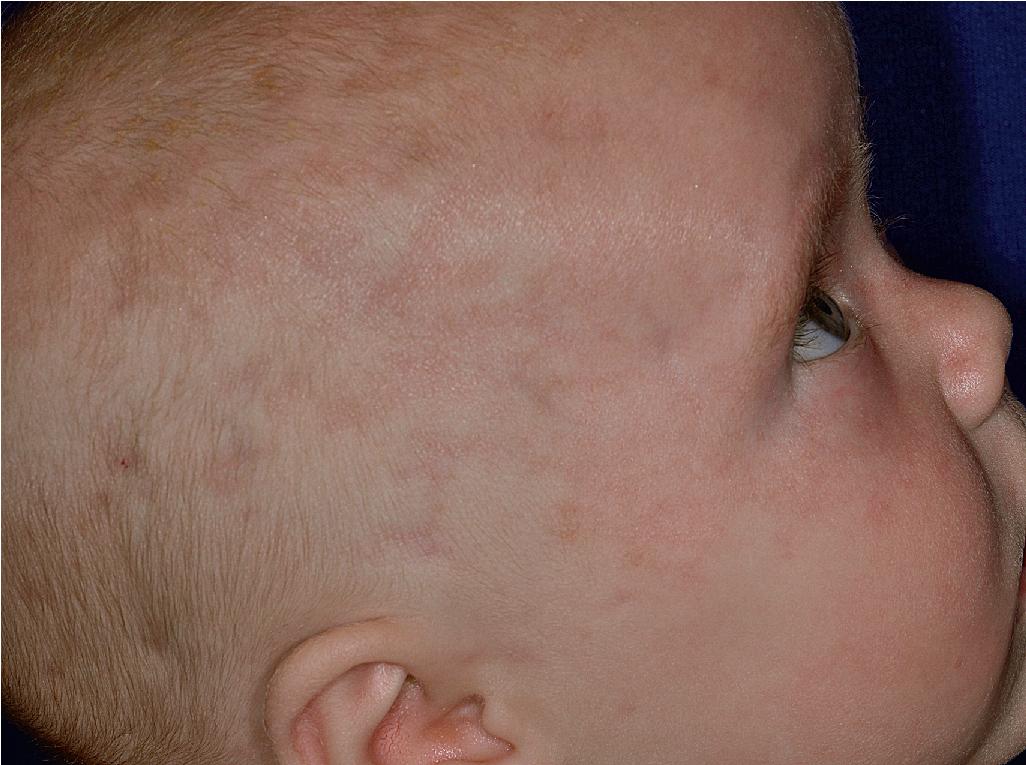
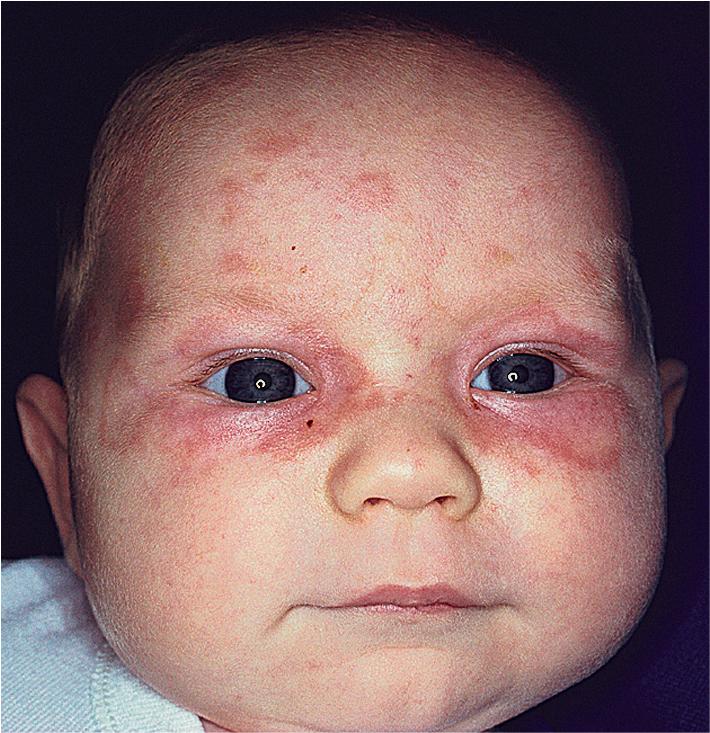
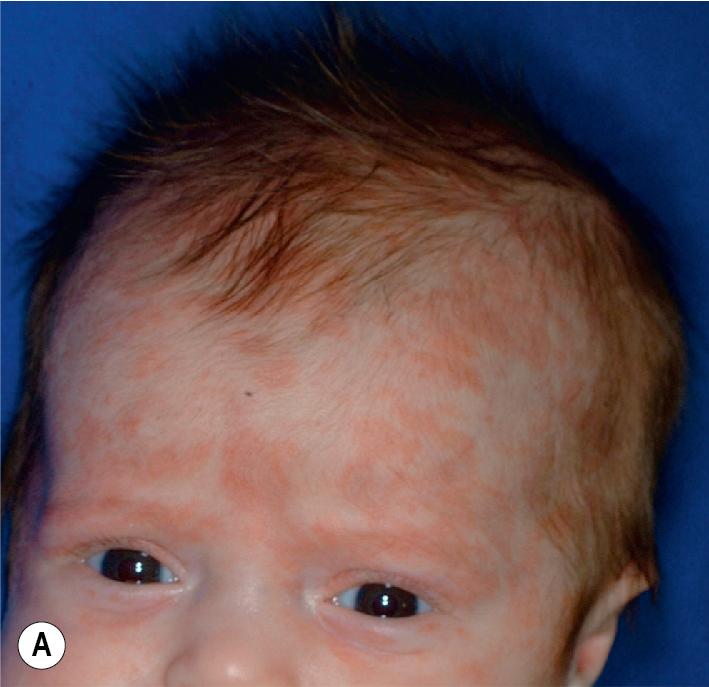
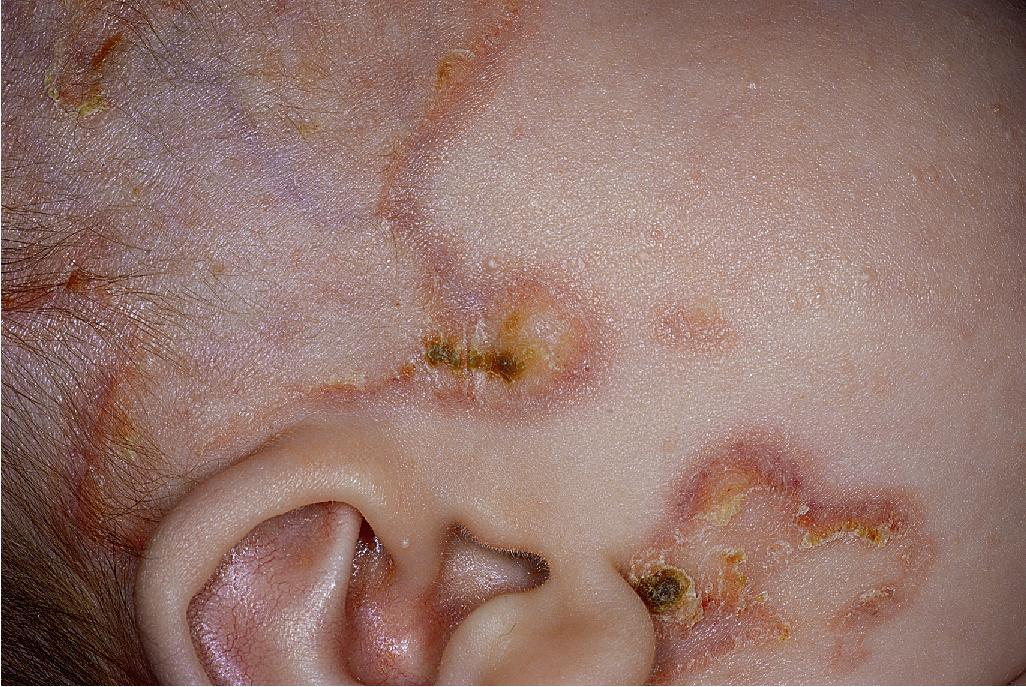
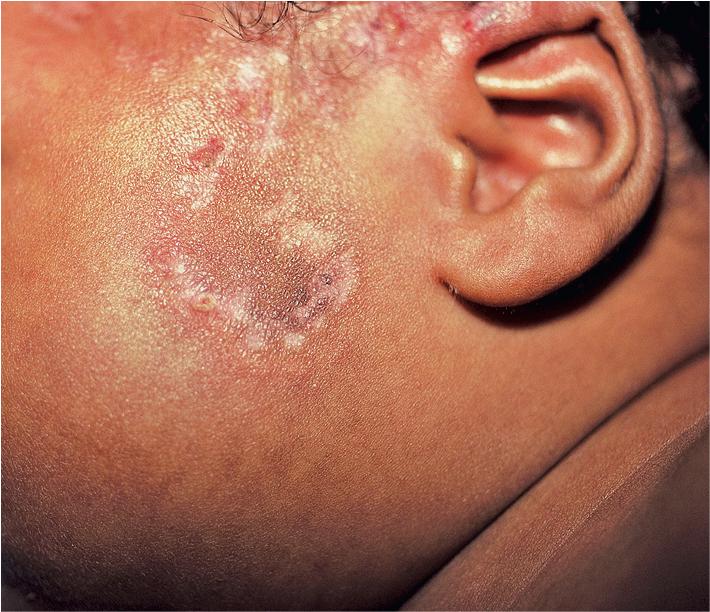
NLE is the most common cause of congenital heart block. Congenital heart block occurs in 15% to 30% of affected patients as a result of in utero inflammation, fibrosis, and calcifications of the atrioventricular node and sometimes the sinoatrial node; 10% of patients with cardiac disease have cardiomyopathy. , Although the cardiomyopathy is usually apparent early, rarely it first manifests several months after birth. Unlike the cutaneous complications of NLE, congenital heart block is usually irreversible. Some infants with first-degree and, rarely, with second-degree heart block have shown spontaneous resolution during the first few months of life, but most patients progress rapidly to third-degree block, including after birth. Two-thirds of infants with heart block require pacemakers. Cardiac disease results in a 20% mortality, not only from the heart block but also congestive heart failure or other associated complications such as transposition of the great vessels, patent ductus arteriosus, septal defects, and endocardial fibroelastosis.
Other systemic complications include liver involvement in 10% to 56% of patients (generally manifested by abnormal liver function tests and sometimes hepatomegaly, but occasionally cholestatic disease and liver failure). , The increase in liver function test levels is typically seen between 3 and 6 months of age. Splenomegaly, lymphadenopathy, and hematologic abnormalities (leukopenia, thrombocytopenia, and both Coombs-positive and Coombs-negative anemia) affect 27% to 33% of infants with NLE. Subclinical evidence of CNS disease, including CNS vasculitis and stroke , as well as hydrocephalus, , has been seen on computed tomographic (CT) scans and ultrasounds in up to 18%. , Although clinical neurologic features are unusual, imaging studies for hydrocephalus are appropriate for NLE infants with a head circumference greater than the 95th percentile. Pulmonary involvement is very rare.
NLE results from the transplacental passage of maternal antibodies. In 95% of cases, these antibodies are anti-Ro (SS-A) antibodies, often in association with anti-La (SS-B) antibodies. These antibodies have been found at sites of pathology in the epidermis and heart. A subset of infants with neonatal lupus and their mothers have anti–U1 RNP (nRNP) antibodies, although cardiac disease is extremely rare in this subset. , Infants and mothers may also demonstrate a positive ANA titer and aPL antibodies. Breastfeeding has not been shown to alter antibody levels or affect the development of cutaneous lesions.
The anti-Ro antibodies have been shown to be causative for the cardiac block. Anti-Ro antibodies bind to fetal, but not to adult, cardiac myocytes and selectively injure the conducting system, a process that involves plasmin ; anti–U1 RNP antibodies do not bind to cardiac myocytes. When pregnant mice are injected with anti-Ro/La antibodies intraperitoneally, the antibody binds to the heart, epidermis, and liver, sites of inflammation in NLE, and is associated with tissue apoptosis. Overall, 10% to 20% of babies of women with anti-Ro with and without anti-La antibodies develop cutaneous NLE; 1% to 2% develop heart block, and 27% have laboratory abnormalities.
The diagnosis of NLE is aided by the presence of typical cutaneous lesions, systemic manifestations, and confirmatory laboratory studies (positive anti-Ro, anti-La, or anti–U1 RNP antibody tests of the infants and mothers). Because of the possibility of involvement of internal organs, a thorough physical examination, complete blood cell count with platelet count, and liver function tests are often recommended for infants suspected of having NLE. Infants with bradycardia or a murmur deserve an electrocardiogram and echocardiography. If any question regarding the diagnosis remains, cutaneous biopsy of a skin lesion can be performed and will show histopathologic features of lupus with injury to the basal epidermal cells as a prominent feature.
Only 10% have persistent anti-Ro antibody at 9 months, and clearance of cutaneous lesions generally occurs by 6 to 12 months of age. In a few patients, however, the cutaneous lesions disappeared within 1 month, and in others, the eruption has lasted up to the age of 26 months. Most cutaneous lesions clear without sequelae; however, cutaneous change may persist, especially on the face and scalp. In a retrospective study of more than 100 patients with a history of NLE, 34% had sequelae, including 17% with dyspigmentation, 13% with telangiectasia, and 9% with atrophic scarring that was associated with having skin lesions at birth. ,
Appropriate treatment of NLE includes avoidance of sun exposure and treatment of visceral complications, which may necessitate administration of systemic corticosteroid therapy. Low- to mid-potency topical steroids or topical calcineurin inhibitors can be used to treat the cutaneous lesions, but lesions clear spontaneously and the use of topical antiinflammatory agents has not been shown to affect risk of residua.
Patients with NLE do not show an increased risk of developing lupus and other autoimmune disorders beyond that of their siblings, suggesting that the small increased risk in this group of patients reflects their familial tendency, not the previous occurrence of NLE. Mothers who have had a child with NLE, however, have a 36% overall risk of having a second affected child, including a 23% risk of cutaneous manifestations and a 13% risk of cardiac issues (almost sixfold higher than the overall risk of congenital heart block in a first affected baby). A mother with a previous baby with NLE involving skin can have a subsequent baby with congenital heart block and vice versa. Fetal echocardiograms (weekly to every other week) between 16 and 26 weeks gestational age, the peak period of cardiac injury, are recommended for at-risk pregnancies. Systemic corticosteroids administered during pregnancy may decrease the risk of first- or second-degree heart block. However, early studies with weekly monitoring have found that steroids do not prevent progression toward third-degree heart block, which can occur quickly in utero . By introducing home monitoring for fetal heart block and rapid detection, treatment with dexamethasone with intravenous immunoglobulin in a small number of fetuses has reversed second-degree but not third-degree heart block. Antimalarials, particularly hydroxychloroquine, are not teratogenic and have been found to decrease the risk of cardiac, although not noncardiac, manifestations of NLE. The combination of steroids with intravenous Ig and plasmapheresis is under investigation.
Antiphospholipid antibody syndrome is an autoimmune thrombotic disorder characterized by venous and/or arterial thrombosis and the persistence of at least one circulating aPL antibody. aPL antibodies in APS are thought to be pathogenic, rather than merely a serologic marker. aPLs are a heterogeneous group of autoantibodies reactive against either negatively charged phospholipids (e.g., phosphatidyl serine and cardiolipin) or proteins that are complexed with them (e.g., β2 glycoprotein I). When APS is suspected, screening should include lupus anticoagulant, anticardiolipin IgG and IgM, and anti–β2-glycoprotein I IgG and IgM.
aPL antibodies are commonly found after bacterial and viral infections in children, leading to the requirement that two tests of aPL antibody levels be performed at least 12 weeks apart for diagnosis. ,
In approximately half of affected pediatric patients, APS is a primary syndrome. The disorder can also occur secondarily, most commonly in children with SLE (38% of children overall). , Patients with SLE and APS may initially have primary APS, with a mean duration of 1.2 years before the onset of criteria to diagnose SLE. , All patients with possible SLE should be screened for aPLs. ANAs and anti-ds DNA antibodies are detected much more commonly in children with secondary APS (86% versus 35% and 59% versus 6%, respectively).
Anticardiolipin, lupus anticoagulant, and anti–β2-glycoprotein I antibodies are found overall in 81%, 72%, and 67% of patients, respectively, without a significant difference between primary and secondary types of APS. Only 33% of pediatric patients have all three antibodies and 48% have two simultaneously, emphasizing the need to evaluate all three antibodies for diagnosis. Of note, having more than one aPL antibody does not increase the risk of thrombosis.
The age of onset is significantly younger in children with primary APS (8.7 versus 12.7 years), and 45% of tested children also have one or more inherited thrombophilic risk factors. These inherited prothrombotic disorders include methylenetetrahydrofolate reductase C677T polymorphism, factor V Leiden, protein S or protein C deficiency, prothrombin G20210A heterozygosity, and antithrombin III deficiency.
Manifestations may range from headache or livedo reticularis to stroke or severe tissue necrosis ( Box 22.3 ). The most common cutaneous manifestations of APS in children are livedo reticularis and Raynaud phenomenon, each occurring in approximately 6% of affected children. Livedo reticularis is characterized by prominent reticulated cutaneous vasculature, most commonly noted on the lower extremities (see Fig. 22.13 and Chapter 12 , Fig. 12.90 ). Thrombosis is the most serious manifestation (see Box 22.3 ), and venous thromboses involving the lower extremities occur most commonly. Recurrent thromboses occur in approximately 20% of children, , , especially with inadequate anticoagulant therapy and with an underlying inherited thrombophilia. The clinical triad of livedo reticularis, hypertension, and cerebrovascular disease, or Sneddon syndrome, is linked to aPL antibodies in individuals and has rarely been described in children.
Become a Clinical Tree membership for Full access and enjoy Unlimited articles
If you are a member. Log in here